
Foundation Document
Little Rock Central High School National Historic Site
Arkansas December 2017
NATIONAL PARK SERVICE • U.S. DEPARTMENT OF THE INTERIOR

Foundation Document
W 13th St
W 14th St
W 15th St
W 12th St
W 16th St
S Schiller St
Jones St
Rice St
Dennison St
W Daisy L Gatson Bates Dr
S Park St
Little Rock
Central
High School
Quigley
Stadium
Little Rock Central High School National Historic Site
Ponder’s
Drug
Store
Magnolia
Mobil
Service
Station
National
Historic
Site
Visitor
Center
Commemorative
Garden

Contents
Mission of the National Park Service . . . . . . . . . . . . . . . . . . . . . . . 1
Introduction. . . . . . . . . . . . . . . . . . . . . . . . . . . . . . . . . . . . 2
Part 1: Core Components . . . . . . . . . . . . . . . . . . . . . . . . . . . . .3
Brief Description of the Park. . . . . . . . . . . . . . . . . . . . . . . . . 3
Park Purpose . . . . . . . . . . . . . . . . . . . . . . . . . . . . . . . . 6
Park Significance . . . . . . . . . . . . . . . . . . . . . . . . . . . . . . 7
Fundamental Resources and Values . . . . . . . . . . . . . . . . . . . . .8
Other Important Resources and Values . . . . . . . . . . . . . . . . . . 10
Related Resources . . . . . . . . . . . . . . . . . . . . . . . . . . . . . 11
Interpretive Themes . . . . . . . . . . . . . . . . . . . . . . . . . . . . 13
Part 2: Dynamic Components . . . . . . . . . . . . . . . . . . . . . . . . . . 14
Special Mandates and Administrative Commitments . . . . . . . . . . . 14
Special Mandates. . . . . . . . . . . . . . . . . . . . . . . . . . . . . 14
Administrative Commitments . . . . . . . . . . . . . . . . . . . . . . . 15
Assessment of Planning and Data Needs . . . . . . . . . . . . . . . . . 16
Analysis of Fundamental Resources and Values . . . . . . . . . . . . . . 16
Identification of Key Issues and Associated Planning and Data Needs . . . 23
Planning and Data Needs . . . . . . . . . . . . . . . . . . . . . . . . . 28
Part 3: Contributors . . . . . . . . . . . . . . . . . . . . . . . . . . . . . . . 31
Little Rock Central High School National Historic Site . . . . . . . . . . . 31
NPS Midwest Regional Office . . . . . . . . . . . . . . . . . . . . . . . 31
Other NPS Staff . . . . . . . . . . . . . . . . . . . . . . . . . . . . . . 31
Appendixes . . . . . . . . . . . . . . . . . . . . . . . . . . . . . . . . . . . 32
Appendix A: Enabling Legislation for Little Rock Central High School
National Historic Site . . . . . . . . . . . . . . . . . . . . . 32
Appendix B: Related Federal Legislation, Regulations,
and Executive Orders . . . . . . . . . . . . . . . . . . . . 35
Appendix C: Past and Ongoing Park Planning and
Data Collection Efforts . . . . . . . . . . . . . . . . . . . . 38
Little Rock Central High School National Historic Site

Foundation Document

The arrowhead was authorized as the
official National Park Service emblem
by the Secretary of the Interior on
July 20, 1951. The sequoia tree and
bison represent vegetation and wildlife,
the mountains and water represent
scenic and recreational values, and the
arrowhead represents historical and
archeological values.
1
Little Rock Central High School National Historic Site
Mission of the National Park Service
The National Park Service (NPS) preserves unimpaired the natural and cultural resources and
values of the national park system for the enjoyment, education, and inspiration of this
and future generations. The National Park Service cooperates with partners to extend the
benefits of natural and cultural resource conservation and outdoor recreation throughout
this country and the world.
The NPS core values are a framework in which the National Park Service accomplishes its
mission. They express the manner in which, both individually and collectively, the National
Park Service pursues its mission. The NPS core values are:
· Shared stewardship: We share a commitment to resource stewardship with the global
preservation community.
· Excellence: We strive continually to learn and improve so that we may achieve the
highest ideals of public service.
· Integrity: We deal honestly and fairly with the public and one another.
· Tradition: We are proud of it; we learn from it; we are not bound by it.
· Respect: We embrace each other’s differences so that we may enrich the well-being
of everyone.
The National Park Service is a bureau within the Department of the Interior. While numerous
national park system units were created prior to 1916, it was not until August 25, 1916, that
President Woodrow Wilson signed the National Park Service Organic Act formally establishing
the National Park Service.
The national park system continues to grow and comprises more than 400 park units covering
more than 84million acres in every state, the District of Columbia, American Samoa, Guam,
Puerto Rico, and the Virgin Islands. These units include, but are not limited to, national parks,
monuments, battlefields, military parks, historical parks, historic sites, lakeshores, seashores,
recreation areas, scenic rivers and trails, and the White House. The variety and diversity
of park units throughout the nation require a strong commitment to resource stewardship
and management to ensure both the protection and enjoyment of these resources for
future generations.

Foundation Document
2
Introduction
Every unit of the national park system will have a foundational document to provide
basic guidance for planning and management decisions—a foundation for planning and
management. The core components of a foundation document include a brief description
of the park as well as the park’s purpose, significance, fundamental resources and values,
other important resources and values, and interpretive themes. The foundation document
also includes special mandates and administrative commitments, an assessment of planning
and data needs that identifies planning issues, planning products to be developed, and the
associated studies and data required for park planning. Along with the core components, the
assessment provides a focus for park planning activities and establishes a baseline from which
planning documents are developed.
A primary benefit of developing a foundation document is the opportunity to integrate and
coordinate all kinds and levels of planning from a single, shared understanding of what is
most important about the park. The process of developing a foundation document begins
with gathering and integrating information about the park. Next, this information is refined
and focused to determine what the most important attributes of the park are. The process
of preparing a foundation document aids park managers, staff, and the public in identifying
and clearly stating in one document the essential information that is necessary for park
management to consider when determining future planning efforts, outlining key planning
issues, and protecting resources and values that are integral to park purpose and identity.
While not included in this document, a park atlas is also part of a foundation project. The
atlas is a series of maps compiled from available geographic information system (GIS) data
on natural and cultural resources, visitor use patterns, facilities, and other topics. It serves as
a GIS-based support tool for planning and park operations. The atlas is published as a (hard
copy) paper product and as geospatial data for use in a web mapping environment. The park
atlas for Little Rock Central High School National Historic Site can be accessed online at:
http://insideparkatlas.nps.gov/ .

3
Little Rock Central High School National Historic Site
Part 1: Core Components
The core components of a foundation document include a brief description of the park, park
purpose, significance statements, fundamental resources and values, other important resources
and values, and interpretive themes. These components are core because they typically do
not change over time. Core components are expected to be used in future planning and
management efforts.
Brief Description of the Park
Little Rock Central High School National Historic Site in Little Rock, Arkansas was established
in 1998. Little Rock Central High School, its 21-acre campus, the former Magnolia Mobil
service station, commemorative garden, National Park Service visitor center, and the former
Ponder’s Drug Store are included within the park boundary. Little Rock Central High School is
still an operating high school and owned, operated, and maintained by the Little Rock School
District. The Magnolia Mobil service station, visitor center, and commemorative garden are
owned and managed by the National Park Service. The total park acreage is 27 acres.
In addition to establishing the national historic site, the park’s enabling legislation states that
the site will “preserve, protect, and interpret for the benefit, education, and inspiration of
present and future generations, Central High School in Little Rock, Arkansas, and its role in the
integration of public schools and the development of the Civil Rights Movement in the United
States.” The legislation also mandates that the site cannot affect the authority of the Little Rock
School District to administer Central High School or the authorities of the City of Little Rock
in the neighborhood surrounding the school.
The national historic site is surrounded by the Central High School Neighborhood Historic
District. The school operates as a four-year public high school under the administration of the
Office of the Superintendent, Little Rock School District. Current enrollment is about 2,500
students. General public access to the interior of the school is restricted to ranger-led tours.

Foundation Document
4
From its dedication in 1927, Little Rock Central High School was recognized as more than the
typical American high school. The massive structure, in the handsome Gothic Revival style,
with blonde brick and architectural details inspired by universities of Western Europe, stood
in contrast to the Art Deco motif of Little Rock’s African American high school, Paul Laurence
Dunbar. Little Rock Central High School was named by the American Institute of Architects
“America’s Most Beautiful High School.” Little Rock Central High School was celebrated
for its size (100 classrooms; capacity for more than 2,000 students; a huge auditorium and
stage) and for its academic excellence. It was a focus of pride and a cultural symbol of the
white community—and became the focus of national attention and a battleground of the Civil
Rights Movement.
On September 4, 1957, desegregation of Little Rock Central High School began when the
first African American students enrolled in the all-white high school. Those nine students
became known as the “Little Rock Nine.” The students attempted to enter the school but were
refused admittance by the National Guard, as ordered by Arkansas Governor Orval E. Faubus.
Segregationist protesters had gathered on South Park Street to chant, pray, and demonstrate
against integration. When the African American students arrived, the protesters threatened,
heckled, jeered, and spit on the students. Reporters and photographers documented the action.
African American reporters became another target of violent protesters. The events of the fall
of 1957, from violence in the street in Little Rock to the involvement of the president of the
United States and U.S. armed forces, have become known as the “Central High Crisis.”
The school desegregation crisis at Little Rock Central High School put on trial America’s
commitment to its founding principles. It was the first significant test of the 1954 Supreme
Court ruling in Brown v. Board of Education that “separate educational facilities are inherently
unequal.” Even more significant, the Little Rock controversy was the first fundamental test of
the national resolve to enforce African American civil rights in the face of massive southern
defiance during the period following the Brown v. Board of Education decisions. The crisis
drew international attention as Little Rock became the epitome of state resistance when
Governor Faubus directly questioned the sanctity of the federal court system and the validity
of the Supreme Court’s desegregation ruling. When President Dwight D. Eisenhower was
compelled by the magnitude of white mob violence to use federal marshals and troops to
uphold the federal court order for African American children to attend the previously all-white
Little Rock Central High School, it was the first time since the post-Civil War Reconstruction
period that federal troops were used in support of African American civil rights.
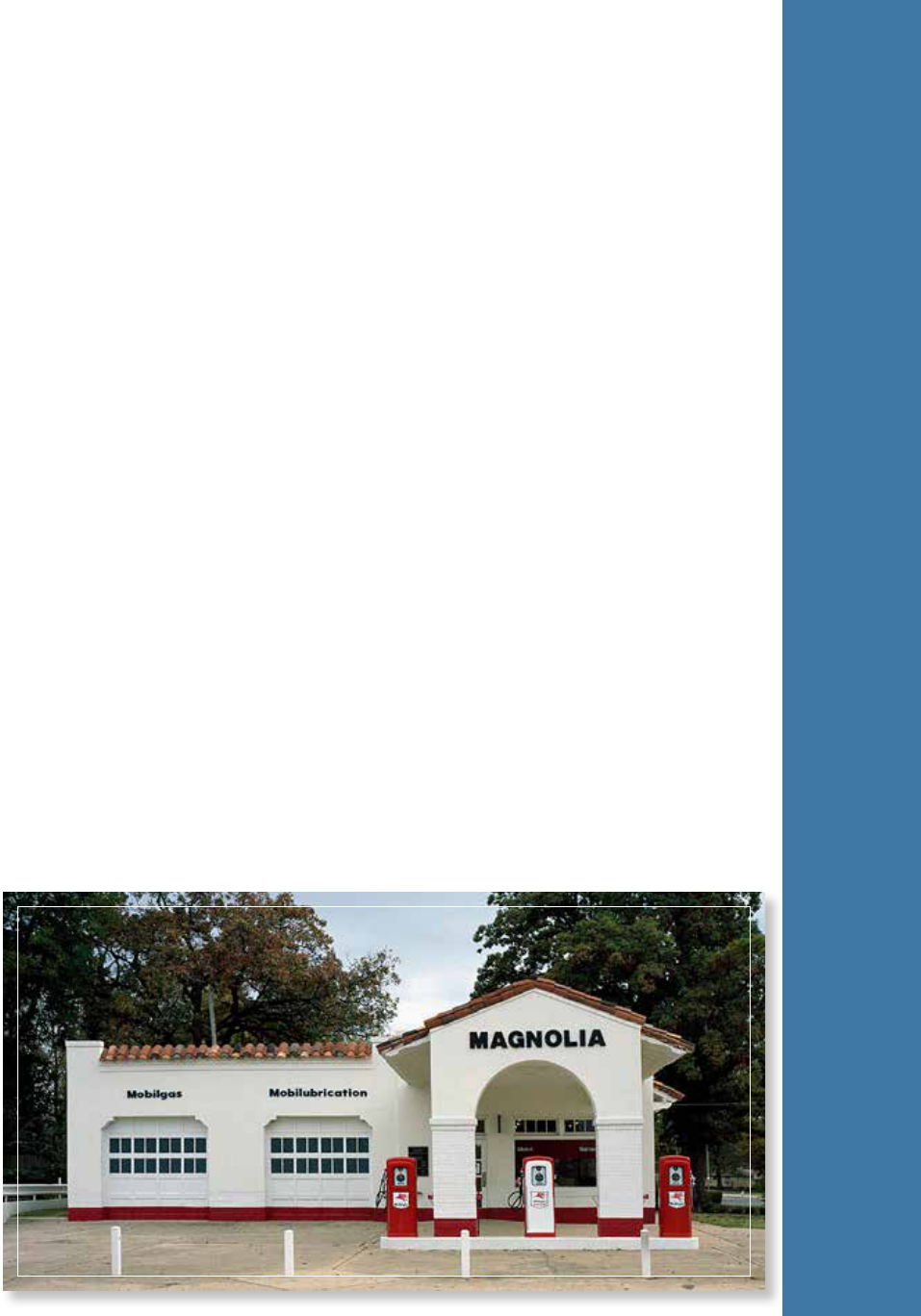
5
Little Rock Central High School National Historic Site
Occurring at the infancy of television, the crisis at Little Rock Central High School was among
the first news stories to be broadcast live as events unfolded. The Magnolia Mobil service
station became an impromptu press base from which reporters called in their stories. The
worldwide coverage, generating outrage at the violent denial of basic rights, became a model for
the Civil Rights Movement’s use of the media over the next decade.
The high school and its 21-acre campus were designated a national historic landmark in
1982. Central High School Historic District was listed in the National Register of Historic
Places in 1996. It is roughly bounded by West 12th and 14th (Daisy L. Gatson Bates Drive)
Streets on the north; Wright and Roosevelt Streets on the south; Doctor Martin Luther King
Jr. Drive on the east; and Jones Street on the west. The district contains 410 contributing
buildings; about half the buildings in the district contribute to its significance. The Central
High School Neighborhood Historic District is not a local ordinance historic district, meaning
it does not fall under the jurisdiction of a local preservation review commission and therefore
does not have the protection of a design review process for major changes that are planned
for the district.
The NPS visitor center is open year round except Thanksgiving, Christmas, and New Year’s
Day. It includes multimedia exhibits providing visitors archival television footage, photographs
and audio from the crisis, its prelude and aftermath, as well as oral histories recorded with
the Little Rock Nine, white students, soldiers, educators, and others who were part of the
historic events. The site interpretation places the events at Little Rock Central High School
in context with other civil and human rights struggles. The National Park Service works with
partners in the community for park operations. To afford NPS access to the school and for
special programs, the National Park Service partners with the Little Rock School District. The
park also partners with the City of Little Rock, Mosaic Templars Cultural Center, University of
Arkansas at Little Rock, Clinton School of Public Service, Philander Smith College, Arkansas
Baptist College, Shorter College, the Little Rock Nine Foundation, and the Daisy and L.C.
Bates Foundation.
In 1957 Daisy Bates was the Arkansas Chapter President of the National Association for
the Advancement of Colored People (NAACP), and was one of the leading champions in
supporting the integration of Central High School. The Daisy and L.C. Bates home became
the battleground to meet and plan as well as a sanctuary for the nine students. The Daisy Bates
House National Historic Landmark was designated in 2001 as a result of the “Desegregation in
Public Education” Theme Study completed in conjunction with the general management plan
for Little Rock Central High School National Historic Site because of the home’s association
with the key stories of the 1957 desegregation crisis at Little Rock Central High School.
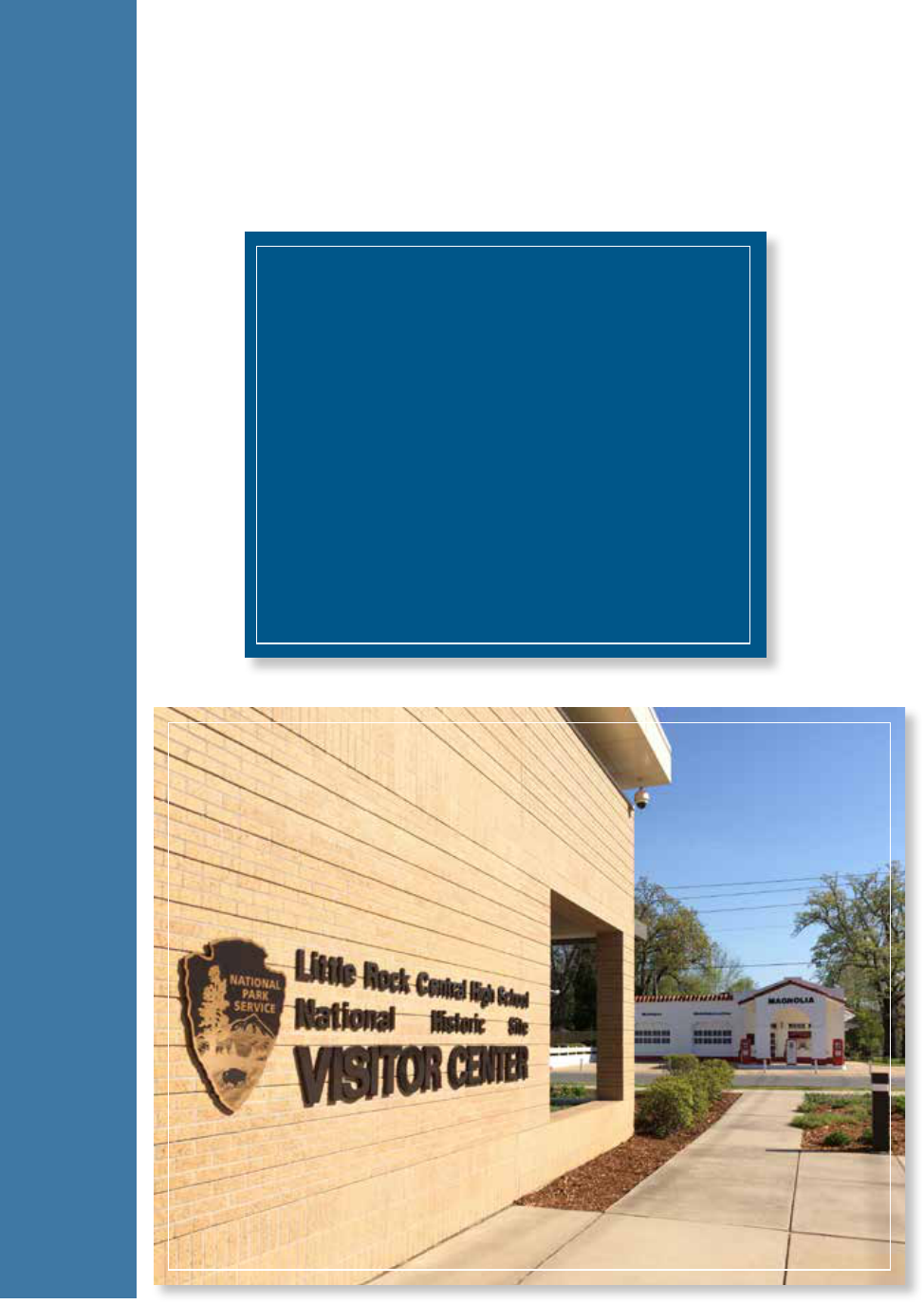
Foundation Document
6
Park Purpose
The purpose statement identifies the specific reason(s) for establishment of a particular
park. The purpose statement for Little Rock Central High School National Historic Site
was drafted through a careful analysis of its enabling legislation and the legislative history
that influenced its development. The park was established when the enabling legislation
adopted by Congress was signed into law on November 6, 1998 (see appendix A for enabling
legislation). The purpose statement lays the foundation for understanding what is most
important about the park.
The purpose of LittLe Rock centRaL HigH
S
cHooL nationaL HiStoRic Site is to preserve,
protect, and interpret for the benefit,
education, and inspiration of present and
future generations, Central High School
in Little Rock, Arkansas, and its role in
the integration of public schools and the
development of the Civil Rights Movement in
the United States. The site serves as a common
ground to provoke shared dialogue for public
awareness of our nation’s transformative
struggle towards equality.

7
Little Rock Central High School National Historic Site
Park Significance
Significance statements express why a park’s resources and values are important enough to merit
designation as a unit of the national park system. These statements are linked to the purpose of
Little Rock Central High School National Historic Site, and are supported by data, research, and
consensus. Statements of significance describe the distinctive nature of the park and why an area
is important within a global, national, regional, and systemwide context. They focus on the most
important resources and values that will assist in park planning and management.
The following significance statements have been identified for Little Rock Central High School
National Historic Site. (Please note that the sequence of the statements does not reflect the
level of significance.)
1. State versus Federal Authority: The defiance of the Arkansas state government in
barring the entry of the Little Rock Nine made Central High School the test case for
federal enforcement of the Brown v. Board of Education Supreme Court decision.
2. Media Spotlight: International media coverage of the 1957 crisis at Little Rock Central
High School elevated the local events to a commentary on American ideals of equality,
making it the most prominent implementation of school desegregation.
3. Values and Conflicts: Central High School is an outstanding representation of how
schools reflect the values and conflicts within a community. “The most beautiful high
school in America” represented the pride of the white community as a premier academic
public school in the nation until it became the symbol of the loss of privilege. To the
African American community, Central High School represented equal opportunity
through education. It was also a symbol of hope, determination, and courage.
4. Consequences: Little Rock Central High School National Historic Site reflects the
consequences, both good and bad, for a community that attempted to implement
legally mandated social change through integration and equal access to education.
Those consequences were typified by the “lost year,” the rise of civic action, and the
underscoring of the importance of education.
5. Civil Rights Legacy: Little Rock Central High School served as a significant case study
and reference point for African Americans’ ongoing civil rights challenges to Jim Crow
segregation, and the role of these events as a catalyst for the Civil Rights Movement,
emphasizing the stories of citizens exercising their fundamental human rights in
pursuance of justice and equality in a land of promise and democracy that remain as
valid today as they were in 1957; and to preserve and protect the tangible resources
associated with those stories.
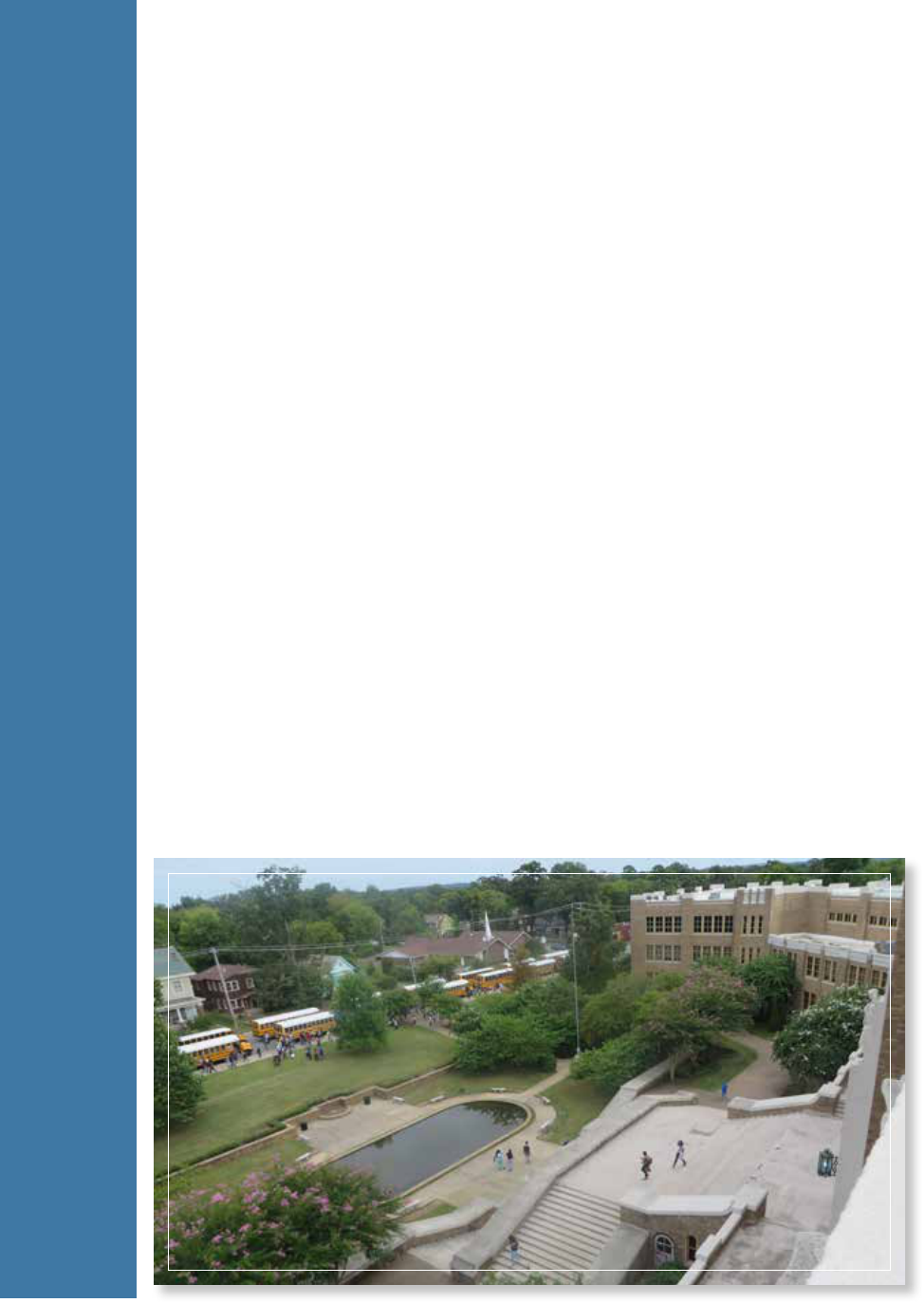
Foundation Document
8
Fundamental Resources and Values
Fundamental resources and values (FRVs) are those features, systems, processes, experiences,
stories, scenes, sounds, smells, or other attributes determined to warrant primary consideration
during planning and management processes because they are essential to achieving the purpose
of the park and maintaining its significance. Fundamental resources and values are closely
related to a park’s legislative purpose and are more specific than significance statements.
Fundamental resources and values help focus planning and management efforts on
what is truly significant about the park. One of the most important responsibilities of
NPS managers is to ensure the conservation and public enjoyment of those qualities
that are essential (fundamental) to achieving the purpose of the park and maintaining
its significance. If fundamental resources and values are allowed to deteriorate, the park
purpose and/or significance could be jeopardized.
The following fundamental resources and values have been identified for Little Rock Central
High School National Historic Site:
· Little Rock Central High School Campus: The campus includes the buildings,
structures, and landscape around the school on 16 acres and four city blocks. The site
also includes the reflecting pool, witness trees, Quigley Stadium and athletic facilities,
and the library building. The National Park Service does not own the school or control
access to the school, but the National Park Service does maintain agreements with the
school district to provide visitor access and shared preservation and interpretation
activities. It is a functioning public school campus.
· Magnolia Mobil Service Station: Located at the southeast corner of Daisy L. Gatson
Bates Drive and South Park Street, it is where the national press took up residence,
using the pay phone there to call in their news stories, as events unfolded in September
1957. The building is currently used as the park’s facility management space.
· Museum Collections: The park maintains a large collection and archive. A large
portion of the collection is oral histories, many of which have been transcribed. Copies
of media coverage of the crisis events are archived. Many of these were mass produced
publications but storing them in one place on site for display, special programs, and
events is important. The collection also includes Central High School artifacts (rings,
yearbooks, photographs) and military hardware (bayonets, rifles, uniforms) from the
101st Airborne Division.

9
Little Rock Central High School National Historic Site
· Streetscape: This is the site where the historic events and confrontations happened,
and includes Park Street from Daisy L. Gatson Bates Drive to 16th Street. The park
boundary is the center line of Park Street. Street experiences were a significant part
of the historic events during the initial crisis, and where the hostile actions took place
at the height of news coverage. The streetscape includes the views of the properties
on the east side of Park Street that are not within the park boundary. Prior to Central
High School desegregation, the neighborhood was racially and economically mixed.
After desegregation, white- and middle class-flight changed the neighborhood. The
neighborhood continues to reflect the lasting impact of the events.
· Ponder’s Drug Store: The drugstore site is important for setting the 1950s scene.
After being turned away from Central High School by the Arkansas National Guard
on September 4, 1957, Elizabeth Eckford attempted to use the telephone at Ponder’s
Drug Store to call for a taxi. The owner of the store, seeing the mob behind her, locked
the door before Eckford could enter. She had no choice but to face the mob until a
bus arrived at the bus stop that would take her to safety. This building is within the
boundary of the park but privately owned. The National Park Service is actively seeking
mechanisms to help preserve and interpret the building.

Foundation Document
10
Other Important Resources and Values
Little Rock Central High School National Historic Site contains other resources and values
that are not fundamental to the purpose of the park and may be unrelated to its significance,
but are important to consider in planning processes. These are referred to as “other important
resources and values” (OIRV). These resources and values have been selected because they
are important in the operation and management of the park and warrant special consideration
in park planning.
The following other important resources and values have been identified for Little Rock
Central High School National Historic Site:
· Commemorative Garden: This symbolic civic space commemorates the events
of 1957. Dedicated in 2001, the garden contains nine trees and nine benches that
symbolize the strength of the Little Rock Nine. Two arches display historic photographs
of Little Rock Central High School dating from 1927 to the beginning of the 21st
century. The garden offers a place to contemplate the past, present, and future.

11
Little Rock Central High School National Historic Site
Related Resources
Related resources are not owned by the park. They may be part of the broader context or
setting in which park resources exist; represent a thematic connection that would enhance
the experience of visitors; or have close associations with park fundamental resources and the
purpose of the park. The related resource represents a connection with the park that often reflects
an area of mutual benefit or interest, and collaboration, between the park and owner/stakeholder.
There are numerous resources related to the Little Rock Central High School story that are not
owned and managed by the National Park Service. Although the National Park Service has no
direct management role in these resources, their continued preservation is of great importance
to the park. The following related resources have been identified for Little Rock Central High
School National Historic Site:
· Daisy Bates House (Little Rock, Arkansas): The Daisy Bates House is a national
historic landmark and is currently a house museum operated by the Daisy and L.C.
Bates Foundation and owned by the Christian Ministerial Alliance. As president of the
Arkansas chapter of the NAACP and co-owner of the Arkansas State Press, Daisy Bates
was well qualified to assume the role as an advocate for the Little Rock Nine. Her house
served as a meeting place for the Little Rock Nine, the NAACP, and the press.
· Pike-Fletcher-Terry House (Little Rock, Arkansas): The Pike-Fletcher-Terry House
is located at 7th Street and Rock Street. Aldophine Terry was a well-known leader of the
Women’s Emergency Committee to Open Our Schools, an organization that met at her
house during the aftermath of the desegregation of Little Rock Central High School.
The house is listed in the National Register of Historic Places.
· State Capitol (Little Rock, Arkansas): The testament statues, life-size statues of the
nine, are on the grounds for the governor and the public to see every day.
· Philander Smith College (Little Rock, Arkansas): A historically black college, the
college had a role in the crisis and today there are significant documents related to
the crisis in the college’s archives. During the three weeks the Little Rock Nine were
not in school, Philander Smith College opened its doors to tutor the nine students,
so they would not fall behind in their studies. Later, Philander Smith College
students would go on to stage sit-ins at local white businesses to protest Jim Crow
segregation laws in Arkansas.
· Paul Laurence Dunbar School (Little Rock, Arkansas): The historically black high
school, junior high, and junior college is a middle school today. Paul Laurence Dunbar
School is listed in the National Register of Historic Places. Opened in 1929, Paul
Laurence Dunbar High School was the premier high school for African Americans in
Arkansas. Despite Central High School having cost $1.5 million and African-American
schools not given the same resources, African Americans looked at Dunbar High
School with pride; as Ellen Turner Carpenter put it “… even though we were separate,
… we did achieve educationally.”
· Horace Mann High School (Little Rock, Arkansas): This school was built as part
of the desegregation plan that was a direct result of the U.S. Supreme Court’s Brown
v. Board of Education decision. It was built from 1955-1956 and opened for the 1956
school year. It is still an active school.
· Hall High School (Little Rock, Arkansas): This school was built as part of the
desegregation plan that was a direct result of the U.S. Supreme Court’s Brown v. Board
of Education decision. It was built from 1955-1956. It is still an active school.
· Arkansas Studies Institute (Little Rock, Arkansas): The institute holds important
collections related to the events at Little Rock Central High School.

Foundation Document
12
· University of Arkansas at Fayetteville (Fayetteville, Arkansas): The university
collections include FBI files, 1957 Little Rock School District Superintendent Virgil
Blossom’s papers, and some of the Daisy Bates papers.
· Wisconsin Historical Society (Madison, Wisconsin): The Wisconsin Historical
Society holds the Daisy Bates collections.
· Carlotta Walls’ Family Home (Little Rock, Arkansas): The Walls family home was
bombed after “the lost year” when Carlotta Walls and Jefferson Thomas returned to
Central High. The home was damaged and repaired, and served as the Walls family
home through the 1950s.
· Mosaic Templars and Ninth Street (Little Rock, Arkansas): The Mosaic Templars
Cultural Center was founded as the Mosaic Templars of America, Center for African
American Culture and Business Enterprise. The museum, part of the Department of
Arkansas Heritage, is dedicated to telling the story of the African American experience
in Arkansas. The center’s name is taken from the Mosaic Templars of America, a
black fraternal organization founded in Little Rock in 1883 whose headquarters sat
on the prominent West Ninth and Broadway location. The museum honors the story
of the Mosaic Templars of America and all of Arkansas’s African American history.
Ninth Street, known as “Black Broadway,” was the heart of the black business district,
featuring numerous businesses dedicated to serving African Americans in Little Rock.
Ninth Street was established as a direct result of Jim Crow segregation laws.
· Trail of Tears National Historic Trail and Underground Railroad Network to
Freedom: Related to the larger story of civil rights, and the “Civil War to Civil Rights”
story. National Park Service Trail of Tears National Historic Trail wayside exhibits are
located on the Arkansas River Trail in North Little Rock’s Riverfront Park. A Trail of Tears
park and walking path is also located on the University of Arkansas at Little Rock campus
off Asher Avenue.
· Camp Joseph T. Robinson (North Little Rock, Arkansas): Camp Robinson is an
Arkansas Army National Guard base. From here, the Arkansas National Guard was
dispatched to the school. In addition, units called up from the U.S. Army 101st Airborne
Division, normally stationed at Fort Campbell, also stayed at Camp Robinson during
the Little Rock crisis. Today Camp Robinson is a major training center for both state
and federal armed forces.
· Governor’s Mansion (Little Rock, Arkansas): Residence of the governor of Arkansas
during the crisis through today. It is also the location of the first recognition of the Little
Rock Nine by the state of Arkansas during Governor Bill Clinton’s administration.

13
Little Rock Central High School National Historic Site
Interpretive Themes
Interpretive themes are often described as the key stories or concepts that visitors should
understand after visiting a park—they define the most important ideas or concepts
communicated to visitors about a park unit. Themes are derived from, and should reflect,
park purpose, significance, resources, and values. The set of interpretive themes is complete
when it provides the structure necessary for park staff to develop opportunities for visitors to
explore and relate to all park significance statements and fundamental and other important
resources and values.
Interpretive themes are an organizational tool that reveal and clarify meaning, concepts,
contexts, and values represented by park resources. Sound themes are accurate and reflect
current scholarship and science. They encourage exploration of the context in which events
or natural processes occurred and the effects of those events and processes. Interpretive
themes go beyond a mere description of the event or process to foster multiple opportunities
to experience and consider the park and its resources. These themes help explain why a park
story is relevant to people who may otherwise be unaware of connections they have to an
event, time, or place associated with the park.
The following interpretive themes have been identified for Little Rock Central High School
National Historic Site:
· The Event: The integration of Little Rock Central High School was a landmark battle
in the struggle for civil rights. It forced the people of a city and a nation to confront their
own situations and issues of racial discrimination, created an international problem
for the country by exposing racism in American society, pitted federal upholding
of constitutional civil rights against states’ rights of self-governance, and provided a
foundation for supporting and forging new attitudes of racial tolerance.
· Civil Rights Movement: The 1957-58 events at Little Rock Central High School
constituted one of many battles in the ongoing struggle for equal rights for all. The
integration of Central High School was the first prominent implementation of the
Brown v. Board of Education decisions by the U.S. Supreme Court. Subsequent events
have demonstrated that racial discrimination would not be obliterated quickly or easily.
· Use of Executive Power: President Eisenhower’s issuance of Executive Order 10730,
which provided “Assistance for the Removal of an Obstruction of Justice within the
state of Arkansas,” represented a national commitment to enforce civil rights. It was
one of the few times that a president has exercised his right to use executive power to
contravene state authority on behalf of civil rights for African Americans.
· The School: Little Rock Central High School is more than a building. It is a symbol of
excellence in education, an architectural achievement, the end of a segregated school
system, and humanity at its best and worst.
· A Moment of Courage: The practical implementation of our nation’s idealized values
tests public tolerance for progressive change. After Brown v. Board of Education, Little
Rock began integrating institutions impacted by Jim Crow laws, providing the impetus
for the NAACP to demand integration of Little Rock Central High School. This choice
of action exposed deep resentment and fear of desegregation—fear that became highly
politicized leading to civil unrest.
· Equal Rights: Little Rock Central High School emphasizes the struggle of civil rights
groups to bridge the gap between the amendments to the Constitution guaranteeing
equal protection under the law and the enforcement of those laws.
· Actions Speak: The stories of individual actions and choices surrounding the crisis
at Little Rock Central High School allow the events of 1957 to be personalized and
underscore the power of the individual.

Foundation Document
14
Part 2: Dynamic Components
The dynamic components of a foundation document include special mandates and
administrative commitments and an assessment of planning and data needs. These components
are dynamic because they will change over time. New special mandates can be established and
new administrative commitments made. As conditions and trends of fundamental and other
important resources and values change over time, the analysis of planning and data needs will
need to be revisited and revised, along with key issues. Therefore, this part of the foundation
document will be updated accordingly.
Special Mandates and Administrative Commitments
Many management decisions for a park unit are directed or influenced by special mandates and
administrative commitments with other federal agencies, state and local governments, utility
companies, partnering organizations, and other entities. Special mandates are requirements
specific to a park that must be fulfilled. Mandates can be expressed in enabling legislation,
in separate legislation following the establishment of the park, or through a judicial process.
They may expand on park purpose or introduce elements unrelated to the purpose of the
park. Administrative commitments are, in general, agreements that have been reached through
formal, documented processes, often through memorandums of agreement. Examples include
easements, rights-of-way, arrangements for emergency service responses, etc. Special mandates
and administrative commitments can support, in many cases, a network of partnerships
that help fulfill the objectives of the park and facilitate working relationships with other
organizations. They are an essential component of managing and planning for Little Rock
Central High School National Historic Site.
Special Mandates
· Public Law 105-356 (2)(b) Administration of Historic Site: The Secretary of the
Interior shall administer the historic site in accordance with this Act. Only those lands
under the direct jurisdiction of the Secretary shall be administered in accordance with
the provisions of law generally applicable to units of the National Park System. Nothing
in this Act shall affect the authority of the Little Rock School District to administer Little
Rock Central High School nor shall this Act affect the authorities of the City of Little
Rock in the neighborhood surrounding the school.
· Public Law 105-356 (2)(c) Cooperative Agreements: The Secretary may enter into
cooperative agreements with appropriate public and private agencies, organizations,
and institutions (including, but not limited to, the State of Arkansas, the City of Little
Rock, the Little Rock School District, Central High Museum, Inc., Central High
Neighborhood, Inc., or the University of Arkansas) in furtherance of the purposes of
this Act.
· Public Law 105-356 (2)(c)(2) Cooperative Agreements: The Secretary shall
coordinate visitor interpretation of the historic site with the Little Rock School District
and the Central High School Museum, Inc.
· Public Law 105-356 (2)(e) Acquisition of Property: The Secretary is authorized to
acquire by purchase with donated or appropriated funds by exchange, or donation
the lands and interests therein located within the boundaries of the historic site:
Provided, That the Secretary may only acquire lands or interests therein within the
consent of the owner thereof: Provided further, that lands or interests therein owned
by the State of Arkansas or a political subdivision thereof, may only be acquired by
donation or exchange.

15
Little Rock Central High School National Historic Site
· Public Law 109-146 Little Rock Central High School Desegregation 50th
Anniversary Commemorative Coin Act: An act to require the Secretary of the
Treasury to mint coins in commemoration of the 50th anniversary of the desegregation
of the Little Rock Central High School in Little Rock, Arkansas, and for other purposes.
The law requires that all surcharges which are received by the Secretary of the Treasury
from the sale of coins issued under this Act shall be promptly paid by the Secretary
of the Treasury to the Secretary of the Interior for the protection, preservation, and
interpretation of resources and stories associated with Little Rock Central High School
National Historic Site, including the following: (1) Site improvements at Little Rock
Central High School National Historic Site. (2) Development of interpretive and
education programs and historic preservation projects. (3) Establishment of cooperative
agreements to preserve or restore the historic character of the Park Street and Daisy L.
Gatson Bates Drive corridors adjacent to the site.
Administrative Commitments
· The park has a cooperative agreement with the Little Rock School District. The exterior
front façade and grounds of Little Rock Central High School are preserved by the Little Rock
School District. The National Park Service provides technical assistance for interpretation
and resource preservation. The park seeks federal and other grants and limited park funding
sources to support the preservation and interpretation of Little Rock Central High School.
The National Park Service cooperates with the Little Rock School District in developing plans
and policies for the buildings and grounds of the entire 21-acre school. A memorandum of
understanding with the Little Rock School District was renewed in February 2017.
· A cooperative agreement for education and interpretation has been developed with
Little Rock Central High School Museum, Inc., the park’s friends group, and is in the
process of being renewed.
· The National Park Service works with city agencies to develop preservation strategies
for protecting the documented architectural and cultural landscape values of the high
school’s surrounding neighborhood.
· Memorandum of understanding with the Central High Neighborhood Association to
assist with development of neighborhood preservation initiatives and establish working
relationships with neighbors.
· The National Park Service has partnerships with organizations such as the Little
Rock Nine Foundation and the University of Arkansas at Little Rock for the
preservation and interpretation of intangible cultural resources (such as oral
histories and personal experiences).
· The National Park Service has had a memorandum of understanding with the City of
Little Rock police for law enforcement and protection at the site. The memorandum is
not current and in the process of being updated as of this document’s publication.
· The National Park Service has an informal relationship to collaborate with the Daisy and
L.C. Bates Museum, Inc., caretakers of the Daisy Bates home, on interpreting the home
and collections.
· The National Park Service has an informal relationship with the Mosaic Templars Culture
Center, frequently collaborating on programs and space for special events. The mission
of the Mosaic Templars Cultural Center is to collect, preserve, interpret and celebrate
Arkansas’s African American history, culture, and community from 1870 to the present,
and to inform and educate the public about African American achievements—especially
in business, politics, and the arts.
· The National Park Service entered into a two-year grant agreement in 2017 with the
City of Little Rock to use African American Civil Rights Grant dollars to repair the
facade of Little Rock Central High School.
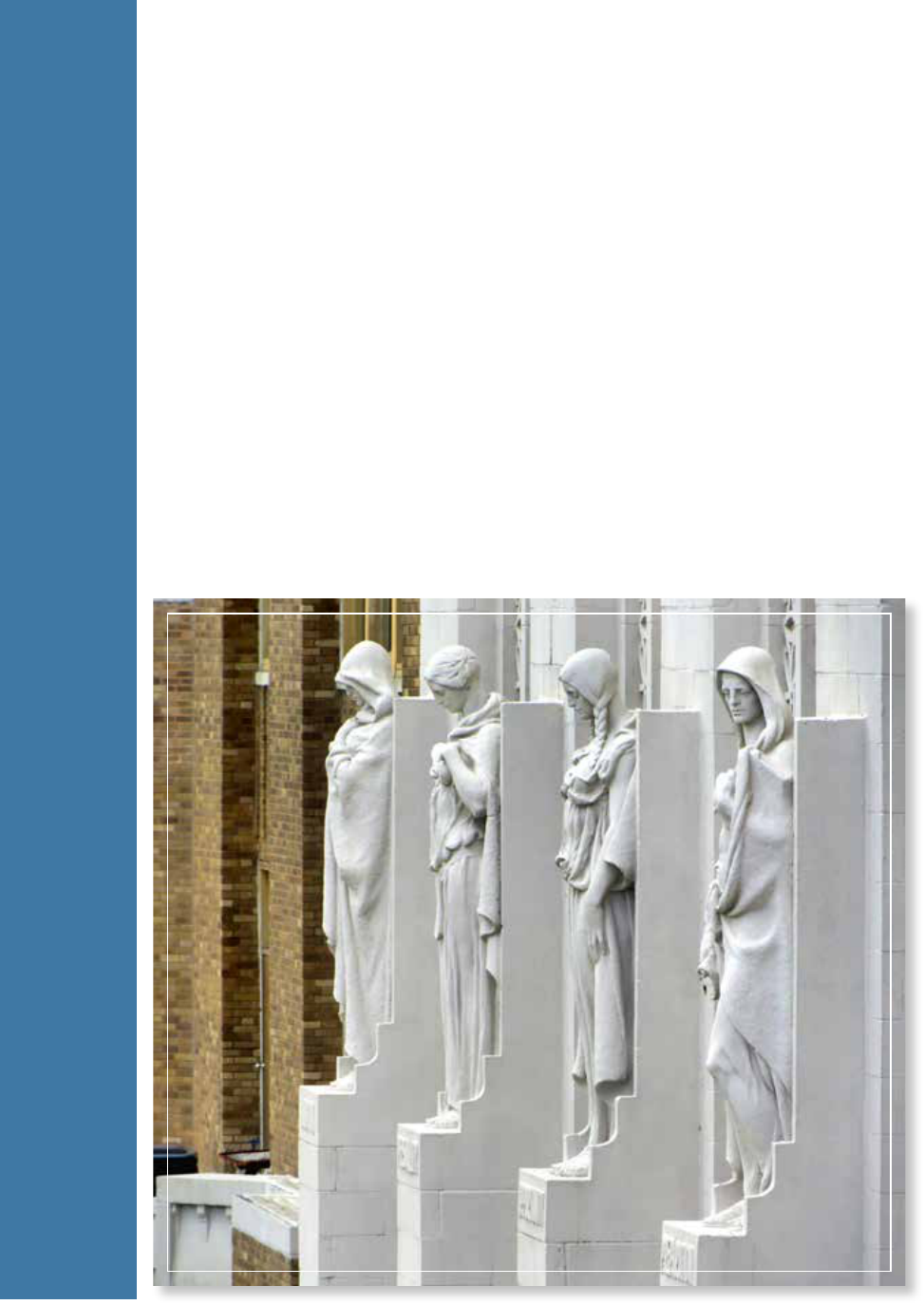
Foundation Document
16
Assessment of Planning and Data Needs
Once the core components of part 1 of the foundation document have been identified,
it is important to gather and evaluate existing information about the park’s fundamental
resources and values, and develop a full assessment of the park’s planning and data needs. The
assessment of planning and data needs section presents planning issues, the planning projects
that will address these issues, and the associated information requirements for planning, such
as resource inventories and data collection, including GIS data.
There are three sections in the assessment of planning and data needs:
1. analysis of fundamental resources and values
2. identification of key issues and associated planning and data needs
3. identification of planning and data needs (including spatial mapping activities
or GIS maps)
The analysis of fundamental resources and values and identification of key issues leads up to
and supports the identification of planning and data collection needs.
Analysis of Fundamental Resources and Values
The fundamental resource or value analysis table includes current conditions, potential threats
and opportunities, planning and data needs, and selected laws and NPS policies related to
management of the identified resource or value.

Little Rock Central High School National Historic Site
17
Fundamental
Resource or Value
Little Rock Central High School Campus
Related Significance
Statements
All significance statements.
Current Conditions
and Trends
Conditions
• The building was constructed in 1927 and costs to preserve the historic fabric are slowly
rising. Originally there were 1,800 students enrolled at the school; now there are more
than 2,500 students.
• Overall, the school is in good condition, but there are structural as well as cosmetic needs
and updates needed for accessibility and routine maintenance.
• Quigley Stadium was constructed in 1936.
• The gymnasium, Tiger Fieldhouse, was added in 1951.
• The present library, also known as the media center, is located between the main building
and the gym. It was built in the 1960s.
• Campus Inn building, made of two connected U.S. Army barracks, was placed on campus
shortly after World War II. The original building was removed and a new structure
stands in place.
• Little Rock Central High School is an active high school.
• The front steps of the school are chipping and need repair. The Little Rock School District
and the City of Little Rock were awarded an NPS grant for Civil Rights site preservation in
2017 for repair and preservation treatment.
• Alumni are active in raising money for the school—more in the athletic and social aspect
of the school—but have made contributions to physical improvements such as replacing
trees that have died. The National Park Service restored the reflecting pool. Alumni
donated benches that now surround the pool bearing names of the Little Rock Nine.
• The agreement with the Little Rock School District was renewed in February 2017
• The main school entry doors and windows were restored in 2016. The original entry doors
were removed for restoration and reinstalled.
• Some bricks on the exterior are deteriorating, and they are being repaired and replaced
as needed.
• Median income in the area is low and the density has dropped. There is deteriorated
housing stock in the community generally but there are also new housing development
projects underway.
• Maintenance needs are greater than the Little Rock School District’s financial capabilities,
particularly as the school district has 51 other schools including three other historically
significant schools that were part of desegregation history—Dunbar, Hall, and Mann.
The school district population has expanded westward and there are demands for new
campuses to serve west Little Rock.
• The school is not required to consult with the National Park Service about routine care and
maintenance. The school collaborates with the National Park Service on big restoration
efforts such as the doors and the new roof. Because Little Rock Central High School is a
national historic landmark, the National Park Service monitors its condition and provides
technical assistance for its preservation.
• The roof was replaced in the last decade (2006-2016), and the school district and the
National Park Service shared the cost. The National Park Service facilitated a Save America’s
Treasures grant for the roof and to replace the HVAC system.
• There are accessibility issues throughout the building—this is an issue for students
especially but also for tours. The elevator is small and the foyer is not wheelchair
accessible, so in order to make the tours accessible the tour route is longer for visitors who
are mobility impaired.

Foundation Document
18
Fundamental
Resource or Value
Little Rock Central High School Campus
Current Conditions
and Trends
Conditions (continued)
• Grounds are well-maintained.
• A fountain in the niche near the reflecting pool needs to be restored.
• The reflecting pool restoration was paid for by an NPS Challenge Cost Share grant
administered by the NPS Midwest Regional Office National Historic Landmark program.
Trends
• Classroom capacity has been exceeded. There are temporary classrooms on the grounds.
Threats and
Opportunities
Threats
• Planned renovations to the football stadium may damage the historic integrity or the
current stadium may be demolished and replaced with a new stadium. The National Park
Service has been in contact with the Arkansas state historic preservation office about the
proposed changes.
• There are desires to renovate or replace the gym as well.
• Mold problems are present in the basement because of water infiltration. There are three
levels of basements in the school.
• The library may have asbestos.
Opportunities
• Lease a classroom from the school to do programing inside Little Rock Central
High School.
• Collaborate with Little Rock School District so that renovations will be sympathetic to the
historic fabric.
• Create distance learning opportunities that would allow classrooms from afar to
explore Little Rock Central High School and conduct distance learning from the school
building itself.
• Work with the Little Rock School District to voluntarily adopt best maintenance practices
for the historic structure.
• Increase cooperation on security for the school, and participate in security planning for
the school.
• Access the school on the weekends for programs. The National Park Service would need to
agree to pay the overtime for the school’s security personnel.
Existing Data and
Plans Related to the
FRV
• Historic structure report.
• Public wifi could be offered to allow visitors to access new digital resources such as the
Arkansas Civil Rights Trail digital guide and to share their experiences on social media.
• Cultural landscape report (2009).
• National historic landmark nomination.
Data and/or GIS Needs
• Administrative history.
• Informal community research with partners.
Planning Needs
• Long-range interpretive plan (update).

Little Rock Central High School National Historic Site
19
Fundamental
Resource or Value
Magnolia Mobil Service Station
Related Significance
Statements
Significance statement 2.
Current Conditions
and Trends
Conditions
• The Magnolia Mobil service station is in use as the park’s facility management space. It was
not meant to be a permanent location, so there are modifications needed to the space for
maintenance operations.
• The building is in good condition and repairs have been done consistently. There has been
recent exterior work.
• Lead and asbestos abatement is needed. There are temporary safeguards in place to avoid
health hazards.
• The building has not been renovated for long-term use. The garage bays were formerly
used by Central High Museum Inc. as display space.
• There is a temporary storage facility (a portable storage shed) on the lot.
• The general management plan calls for this building to be converted into an
education space.
• Workspace is inadequate for needs. There has been no decision to designate the building
as the long-term park maintenance facility, and it has therefore not been modified for
optimal maintenance use.
• This is the only historic structure owned by National Park Service within the park boundary.
• An extension was added on the Magnolia Mobil service station by Central High School
Museum, Inc. in 1997.
Trends
• There is a benefit and cost savings to having the maintenance operation on site.
• Space is not adequate for current education center needs. It is a very tight space, so
beyond distance learning use, it would not fulfill any unmet needs for onsite education
programs that need more space.
Threats and
Opportunities
Threats
• Break-ins at the portable storage shed have happened in the past.
• Lead or asbestos not removed. Lead paint has been identified in the lobby area that is
proposed for interpretive use and needs to be abated.
• Limited space for programs and staff.
Opportunities
• Continued use as a maintenance facility—this is in keeping with the historic use.
• Use the lobby as an interpretive area.
Existing Data and Plans
Related to the FRV
• Historic structure report.
• Cultural landscape report (2009).
Data and/or GIS Needs
• None identified.
Planning Needs
• General management plan amendment.

Foundation Document
20
Fundamental
Resource or Value
Museum Collections
Related Significance
Statements
All significance statements.
Current Conditions
and Trends
Conditions
• There is a backlog of collection items to be accessioned, primarily alumni donations and
interpretive program audio visual recordings, because there is no curator position at the
park. Interpreters do curatorial work to update what the park has, including accessioning
and de-accessioning collection items.
• Park partner University of Arkansas at Little Rock and the National Park Service have
obtained grant funds for museum collection projects.
• For the collections stored on site, climate control is good and the space is adequate
for needs.
• A large part of the collection includes many hours of oral histories.
• Park administrative history materials are increasing and a lot of park history is being saved;
these materials are a bulk of the accessioning and cataloging backlog.
• The park is collaborating with the University of Arkansas at Little Rock Center for
Arkansas History and Culture. The project is titled “The Road from Hell is Paved with
Little Rock: Digitizing the History of Segregation and Integration of Arkansas Educational
Systems.” This 18-month project brings together the University of Arkansas at Little
Rock Center for Arkansas History and Culture and the Central Arkansas Library System
Butler Center for Arkansas Studies to digitize collections from three institutions, which
include manuscripts, oral histories, photographs, and audio-visual recordings.
Trends
• The collection is slowly growing, largely from individual donations.
• Efforts to collect oral histories from participants and witnesses to the 1957-59
desegregation crisis will continue to be significant as the Little Rock Nine, their classmates,
and the soldiers ordered to Central High enter their 70s and 80s.
• Oral histories are in the process of being digitized.
• The park has partnered with University of Arkansas at Little Rock Institute for Arkansas
Studies to digitize the park collection as well as crisis related artifacts from other archives
and museums and provide a central online access point for researchers and students.
Threats and
Opportunities
Threats
• There are potential threats to important items that are not in NPS ownership but could
potentially come to NPS custody.
• Physical documentation (the paper trail) is outdated. If the Interior Collections
Management System program crashes, information will be lost.
Opportunities
• Expand interpretive programming around collection items.
• The NPS Centennial (2016) initiative made 100 artifacts available to the public.
• Increase outreach to identify items held by others that could be better protected by the
National Park Service.
• Refocus resources on maintaining collections to NPS standards.
Existing Data and Plans
Related to the FRV
• Scope of collections statement update (2017).
• Emergency plan.
Data and/or GIS Needs
• Administrative history.
Planning Needs
• Integrated pest management plan.

Little Rock Central High School National Historic Site
21
Fundamental
Resource or Value
Streetscape
Related Significance
Statements
All significance statements.
Current Conditions
and Trends
Conditions
• The park boundary line is the center of Park Street.
• The park has a good relationship with the homeowners along the east side of Park
Street. The park has a good relationship with the neighborhood association.
• Most neighbors do a good job maintaining their properties and conserving the streetscape.
• There is good documentation of the historic streetscape and houses from photographs
and video from the crisis.
• Interpretive stories about the mob attacks on reporter Alex Wilson and on Elizabeth
Eckford are told using the streetscape.
• There is a large tree along the street that is important to interpretive stories.
• Ponder’s Drug Store streetscape includes the location of the bus stop that was outside the
drugstore where Elizabeth Eckford met Grace Lorch and Dr. Benjamin Fine and waited for
the city bus.
• Sidewalks are experiencing heaving from tree roots. Shrubbery from neighboring property
intrudes on the right-of-way.
• The Park Street block has remained largely architecturally intact and unaltered since 1957
(one home was damaged by fire several years ago).
• The park is within a historic district in Little Rock—Central High School Neighborhood
National Historic District.
• Little Rock has tax incentives in place for property owners within the historic district
including Park Street.
Trends
• Four houses on Park Street are currently vacant. One vacant house is owned by the City
of Little Rock, which has committed $300,000 to restoration. The house will be used for a
neighborhood resource center. Restoration work began in August 2016.
• Property owners have submitted a request to U.S. Senator John Boozman’s office for
legislation to expand the park boundary.
Threats and
Opportunities
Threats
• Private homeowners may have limited resources to maintain the historic integrity of their
homes and yards.
• Developers purchasing buildings along Park Street could lead to changes that would
diminish the historic integrity of the streetscape.
Opportunities
• Install a bench in the approximate location of the bench that Elizabeth Eckford sat on while
she waited for the bus that echoes the character of the original bench.
• Expand the park boundary to include the houses on Park Street.
• Develop partnerships to support homeowners securing funding to maintain the historic
integrity of their homes and streetscape.
Existing Data and Plans
Related to the FRV
• National Register of Historic Places historic district nomination.
Data and/or GIS Needs
• None identified.
Planning Needs
• Land protection plan (update).
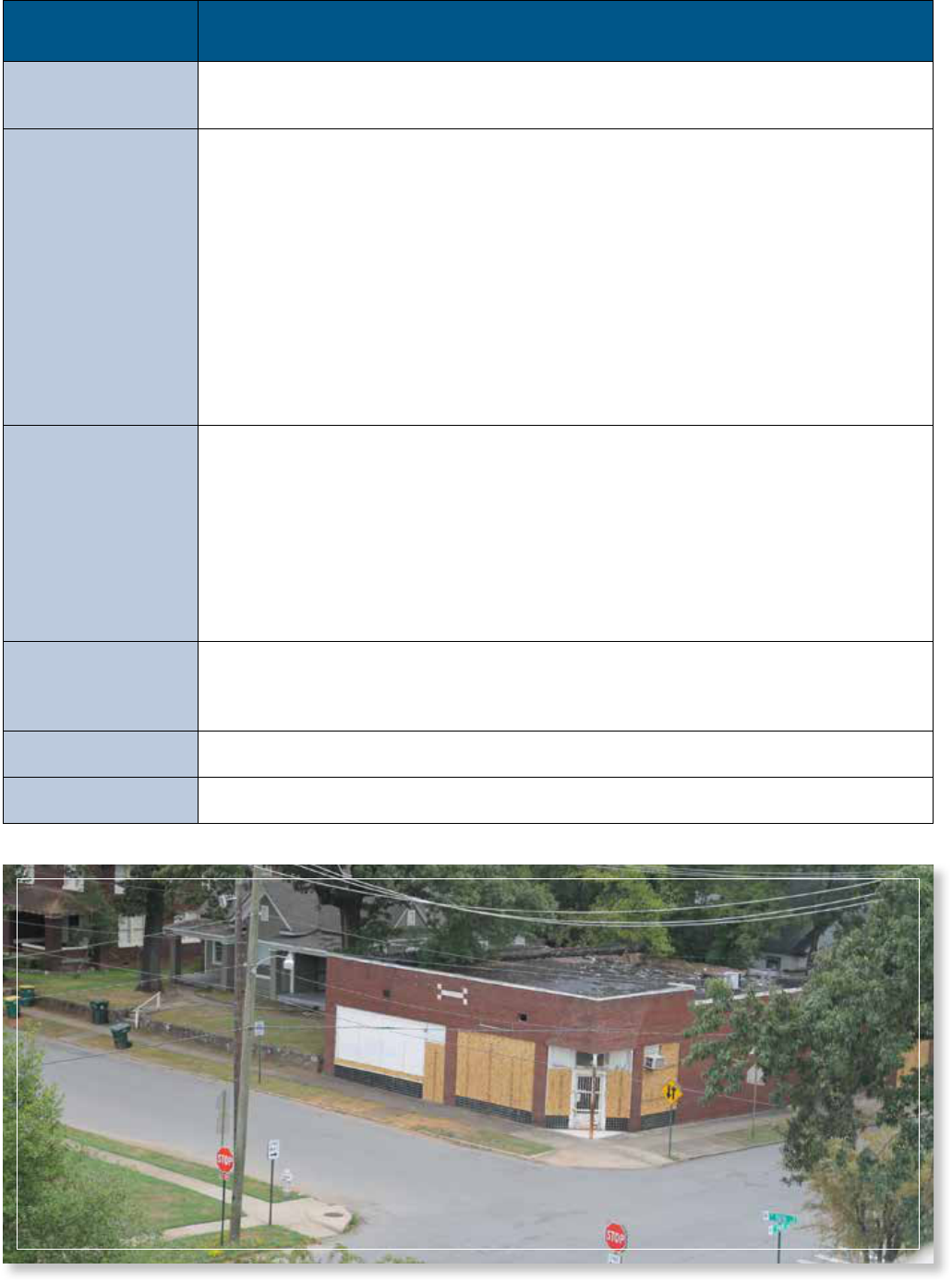
Foundation Document
22
Fundamental
Resource or Value
Ponder’s Drug Store
Related Significance
Statements
Significance statements 3, 4, and 5.
Current Conditions
and Trends
Conditions
• The property is within the park boundary but the National Park Service does not own it.
• The building is vacant and in poor condition. The roof caved in and the building is a haven
for wildlife, feral cats, and the homeless.
• Despite its poor condition it has moderate integrity as assessed by the 2009 cultural
landscape inventory.
• The building was in use by businesses through the late 1990s.
• The building needs a structural assessment to definitively determine its condition.
• The building is also known as the Capel building.
Trends
• Deterioration is ongoing and will increase rapidly if left unmanaged.
Threats and
Opportunities
Threats
• Further deterioration, especially without a roof, is a significant threat.
• Fire could destroy the building.
• The building has become a beacon for criminal activities and gang communication. This
could threaten the safety of visitors and staff and result in resource damage from vandalism.
Opportunities
• The building owner could raise funds with partners to restore the building,
especially the roof.
Existing Data and Plans
Related to the FRV
• Historic structure report.
• Cultural landscape report (2009).
• National Register of Historic Places historic district nomination.
Data and/or GIS Needs
• None identified.
Planning Needs
• None identified.

23
Little Rock Central High School National Historic Site
Identification of Key Issues and Associated Planning and Data Needs
This section considers key issues to be addressed in planning and management and therefore
takes a broader view over the primary focus of part 1. A key issue focuses on a question that is
important for a park. Key issues often raise questions regarding park purpose and significance
and fundamental and other important resources and values. For example, a key issue may
pertain to the potential for a fundamental or other important resource or value in a park to be
detrimentally affected by discretionary management decisions. A key issue may also address
crucial questions that are not directly related to purpose and significance, but which still affect
them indirectly. Usually, a key issue is one that a future planning effort or data collection needs
to address and requires a decision by NPS managers.
The following are key issues for Little Rock Central High School National Historic Site and the
associated planning and data needs to address them:
· Boundary Expansion for Resource Protection: The houses and streetscape on Park
Street across from Little Rock Central High School are not within the boundary of the
park. These are important components of the cultural landscape and important to the
story of the events of 1957. Inclusion within the boundary would provide opportunities
for future adaptive uses if any of the houses became available for acquisition. This could
include volunteer and seasonal housing, educational space for youth, and additional
park program space. Inclusion of these houses in the boundary was recommended
in the 1998 special resource study. Boundary change legislation is pending in the U.S.
Congress. A land protection plan update would be needed.
The park also proposed a boundary expansion to include the seven residential
properties along the east side of the Park Street corridor. The boundary adjustment
would add 1.47 acres to the park, thereby making the total acreage boundary 28.88
acres. The park contacted all of the property owners and none of them objected
to the boundary expansion. Many of the property owners have advocated for the
boundary expansion and the proposed expansion has the support of the neighborhood
association and other owners in the neighborhood.
In addition to the boundary adjustment, the park is requesting legislative authorization
to enter into cooperative agreements with the owners of these and other nonfederal
properties within the park boundary to provide assistance with preservation and
interpretation of the properties. This authority would support resource protection
goals; it also will provide an alternative for protection of the properties other than
federal fee acquisition.
- Associated planning and data needs: Land protection plan (update)
· Facility Management Space: The Magnolia Mobil service station currently houses the
facility management division. It is small and not adequate for all facility management
needs. The division is functioning in the facility despite its limitations, and the
advantages of operating from an on-site facility outweigh the problems of managing
from a remote rented facility. Property is on the market across from the visitor center
and adjacent to the Commemorative Garden. Acquisition of the property could provide
an opportunity to construct a maintenance facility or an education center. A general
management plan amendment would be needed.
- Associated planning and data needs: General management plan amendment

Foundation Document
24
· Education Center: The size of the park visitor center multipurpose room limits its
capacity to 25-30 people, which limits the park’s programing opportunities. School
groups are the largest segment served by the park and group sizes typically exceed
the visitor center capacity. There is periodic need to serve groups of 80-100 people.
The park conducts programming for large groups in other community spaces
such as the Mosaic Templar building, and these facilities are not always available
when needed. Lack of an adequate on-site space reduces the park’s visibility in the
immediate community.
The visitor center was not designed to serve as an education center. The park’s
general management plan identifies the need for an education center and proposes
the Magnolia Mobil service station, but that building is of inadequate size and
configuration to provide education programming space. The service station is more
compatible with maintenance uses. Changes to the Arkansas curriculum standards are
expanding the grade levels and numbers of students that the park needs to serve. NPS
programs such as Every Kid in a Park are also increasing demand for education center
space. There is a parcel next to the commemorative garden that the park and friends
group are jointly exploring as a site for a civil rights education center building which
would include space for artist-in-residence and evening programs.
There is also a need for improved staging of Little Rock Central High School tours.
The park offers daily tours at 9:00 a.m. and 1:00 p.m. Tour size is limited to 50 people.
Groups above this size cannot be staged from the visitor center and it is difficult to move
across the intersection of Daisy L. Gatson Bates Drive and Park Street. An education
center on the same side of the street as the high school and near the visitor center could
allow for better, safer large group staging and reduce the impact of the intersection.
Improved space could allow more diverse programming and better tailoring of
programs to meet specific group interests. Flexible space would allow programs to be
diversified for different demographics, allow more hands-on programs, and better serve
people with mobility issues. A well-designed education center could provide space for
rotating exhibits and community space for use by park partners and other local groups,
including volunteers from Little Rock Central High School involved in programs such
as student mentoring.
- Associated planning and data needs: General management plan amendment, long-
range interpretive plan (update), informal community research with partners

25
Little Rock Central High School National Historic Site
· Agreements and Partnership Needs: The agreement with the Little Rock School
District was renewed in February 2017. Some renewals are on regional review in the NPS
Midwest Regional Office. Others need refinement. There is a need for a stronger and
better defined partnership agreement with the school district that could include improved
consultation and coordination of Little Rock Central High School building maintenance
and repair. Coordinating and forecasting future issues, such as major renovation and
maintenance projects, would improve NPS programming of funds. The school district has
no intention of closing Little Rock Central High School, but an agreement could allow the
National Park Service a right of first refusal if the school were ever closed and excessed.
- Expanded partnership (through memorandums of understanding) or cooperative
agreement opportunities could also be established with:
· University of Arkansas, Little Rock
· University of Arkansas at Little Rock Bowen School of Law
· University of Arkansas Clinton School of Public Service
· Arkansas River Trail Alliance and Bicycle Advocacy of Central Arkansas
· The Central High School neighborhood association and other community
organizations
· Mosaic Templars Cultural Center
· Arkansas Children’s Hospital
· Little Rock Central High School Museum, Inc. (The park’s friends group;
agreement in the process of reinstatement)
· The City of Little Rock
· The Little Rock Chamber of Commerce
· Shorter College
· Baptist College
· Hendricks College
· MetroPlan, a metropolitan area agency for wayfinding and intermodal
transportation
- Associated planning and data needs: None identified

Foundation Document
26
· Visitor Center / Park Headquarters Safety: The visitor center building is a
prominent building in the neighborhood and its attractiveness presents safety issues.
There are repeated instances of homeless and mentally ill individuals entering the
visitor center seeking refuge from the weather or to use the restrooms. The park staff
has had some training with the Veterans Administration, psychologists, and Little Rock
Police Department to understand how to deal with homeless/mentally ill visitors. A
standard operating procedure should be developed to effectively manage this issue. The
park is also concerned with the potential of the visitor center building as a target for
terrorist activities. Active shooter training through the Little Rock Police Department
is being considered and is available on the U.S. Department of Homeland Security
website. This could be coordinated with the high school. The goal is for the visitor
center to be perceived as a cornerstone of the community.
- Associated planning and data needs: None identified
· Pedestrian Safety: There are safety concerns at the intersection of Daisy L. Gatson
Bates Drive and Park Street. This is a four-way stop intersection with substantial east-
west traffic on Daisy L. Gatson Bates Drive. There is concern with traffic speeds and the
lack of traffic calming mechanisms (e.g., speed bumps) to slow traffic approaching the
intersection. There is also a concern about pedestrian safety during police car pursuits
in the area, and the park has contacted the Little Rock chief of police with this concern.
Police officers are not supposed to participate in pursuits in high pedestrian areas. The
park is planning to develop a memorandum of understanding or other agreement with
the police department, and that stipulation will be included in the agreement.
Park tours must cross the intersection and safety orientation is provided to visitors
prior to the start of tours. There is not a sidewalk curb cut in the crosswalk between
the visitor center and the commemorative garden. This is a safety concern and an
accessibility issue. It requires that visitors with strollers and the mobility impaired spend
more time than desired in traffic lanes while crossing the street. There is an opportunity
to redesign the intersection and crosswalk access to improve visitor and staff safety. The
City of Little Rock Complete Streets Plan includes planned bike lanes in the Central
High School Neighborhood Historic District. Bike lanes, in addition to a pilot city bike
share program, may increase the number of visitors and students traveling the park by
bicycle. The Federal Highway Administration granted a rail-to-trail grant to Pulaski
County to plan a hiking/biking trail connecting Central High School National Historic
Site with Hot Springs National Park. This trail development would increase the number
of park visitors arriving on foot and by bicycle.
- Associated planning and data needs: Intersection improvements design

27
Little Rock Central High School National Historic Site
· Outreach and Relevancy to Broader Audiences: Park staff and facility capacities
significantly limit opportunities to reach the broadest range of visitors and interests.
As noted above, the constraints of the visitor center limit the size of groups and the
types of activities that can be accommodated on site, and additional programming and
outreach would require more than the three available staff positions.
There are opportunities to overcome some of the staff and physical space
constraints through digital communications technology. The park does not,
however, have adequate technology or sufficient space for digital outreach. This
limits the reach of park interpretation, including outside the park boundary to
schools and community organizations.
There are numerous technologies that could support programming such as virtual tours
of Little Rock Central High School and that could be received on devices commonly
available to the public (e.g., smartphones and tablets). Virtual events could be live
and interactive or could be pre-recorded. Digital park collections could be integrated
into presentations and could expand public access to the park’s collection, thereby
increasing visitor appreciation of the resources and stories. Programs such as virtual
geocaching could also expand interest in the park to broader populations.
Technology could increase the park’s reach to interests beyond Little Rock. This
could include nationwide audiences with interests in broader civil rights stories
such as the LGBT community, other oppressed minorities, and constitutional issues.
There is substantial visitation after hours to the Little Rock Central High School
neighborhood and the streetscape. Programming through digital technologies could
reach those visitors regardless of their time of visit. This could also give the park a
better sense of the volume of visitation to the park when the visitor center is closed.
Completion of a planned bicycling/pedestrian trail between the park and Hot
Springs National Park will likely increase visitation, including after hours.
Digital technologies, such as smartboards, could be updated with changing information
that is not as easily provided by physical exhibits. This would provide opportunities to
connect the themes of the site to current events and community engagement.
- Associated planning and data needs: Long-range interpretive plan (update), informal
community research with partners

Foundation Document
28
Planning and Data Needs
To maintain connection to the core elements of the foundation and the importance of these
core foundation elements, the planning and data needs listed here are directly related to
protecting fundamental resources and values, park significance, and park purpose, as well
as addressing key issues. To successfully undertake a planning effort, information from
sources such as inventories, studies, research activities, and analyses may be required to
provide adequate knowledge of park resources and visitor information. Such information
sources have been identified as data needs. Geospatial mapping tasks and products are
included in data needs.
Items considered of the utmost importance were identified as high priority, and other items
identified, but not rising to the level of high priority, were listed as either medium- or low-
priority needs. These priorities inform park management efforts to secure funding and support
for planning projects.

Little Rock Central High School National Historic Site
29
Planning Needs – Where A Decision-Making Process Is Needed
Related to an FRV
or Key Issue?
Planning Needs
Priority
(H, M, L)
Notes
FRV, Key Issue General
management plan
amendment
H Since the completion of the park’s current general
management plan, conditions have changed at the
park. Clearly stated vision and management direction
is needed for the park and to guide collaboration
with park partners. An amendment is also needed
to look at current use and future needs for facility
management and education center space. The plan
could consider repurposing existing exterior spaces as
well, especially outside the visitor center, for example,
providing more seating. The plan would need to
address the bicycling/walking trail that is planned
to connect the park and Hot Springs National Park
and a planned connection between the park and
the Arkansas River Trail. The plan may also need to
account for a boundary expansion if legislated.
FRV, Key Issue Long-range
interpretive plan
(update)
H The park’s existing long-range interpretive plan is from
2004, which is before the current visitor center was
built, and is no longer a template to plan annual goals.
A new plan is needed to respond to new conditions,
new technology, servicewide initiatives, and outreach
and relevancy goals.
Key Issue Intersection
improvements
design
H Redesign intersection and crosswalk access to improve
visitor and staff safety. Initial planning is underway with
the city and the NPS Midwest Regional Office.
FRV Integrated pest
management plan
M Needed for protection of museum collections.
FRV, Key Issue Land protection
plan (update)
L Would only be needed if boundary adjustment is
approved to incorporate additional properties.

Foundation Document
30
Data Needs – Where Information Is Needed Before Decisions Can Be Made
Related to
an FRV or
Key Issue?
Data and GIS Needs
Priority
(H, M, L)
Notes
FRV, Key Issue Informal community
research with partners
M This is an ongoing effort to understand potential visitors
who are not coming to the site in order to better target
outreach. How do we become more audience centered?
Are we really serving the community? How do we address
changing lifestyles, changing demographics, changing
values? How do we adapt? How do we learn this through
our partners? Issues in this community that we need to
address include education systems, illiteracy, poverty, and
drugs. How do we acknowledge community needs and
show them they are valued? How do we build trust for a
mutual exchange? Listening! Park staff have conducted
town hall meetings to listen to community concerns.
Explore opportunities to work with other parks and
agencies that face similar challenges. Are there templates
for best practices in community engagement? What is
the support for building on what we already have? This
originally came from thinking about what people want
to hear about when they come to this site. Is it meeting
needs; how do we attract new audiences?
FRV Administrative history M Related to museum collections, develop a better
understanding of what aspects of NPS management
history are important, and what is important to save
in park collections related to the NPS era of the site.
Park needs to keep a record of interpretation/education
programs, outreach, and special events to serve as
templates—including summaries with what worked
and what did not. Conduct exit interviews with staff to
preserve NPS history and retain institutional knowledge.

31
Little Rock Central High School National Historic Site
Part 3: Contributors
Little Rock Central High School National Historic Site
Robin White, Superintendent
Enimini Ekong, Chief of Interpretation (former)
Jodi Morris, Acting Chief of Interpretation
Chelsea Mott, Park Guide
Roberto Ruiz, Laborer
Michael Douglass, Laborer
Fabian Ruiz, Park Guide
Toni Webber, Visitor and Volunteer and Parks Assistance
Evan Webber, Acting Facility Manger
NPS Midwest Regional Office
Natalie Franz, Planner
Other NPS Staff
Tarona Armstrong, Superintendent, President William Jefferson Clinton Birthplace Home
National Historic Site
Brian D’Agosta, Contract Visual Information Specialist, Denver Service Center —Planning
Christian Davis, Park Ranger, President William Jefferson Clinton Birthplace Home
National Historic Site
Loren McLane, Park Ranger/Historian, Fort Smith National Historic Site
Pam Holtman, Quality Assurance Coordinator, WASO Park Planning and Special Studies
John Hoesterey, Contract Planner, Denver Service Center —Planning
Nancy Shock, Foundation Coordinator, Denver Service Center—Planning
Philip Viray, Publications Chief, Denver Service Center—Planning
Laura Watt, Contract Editor, Denver Service Center —Planning
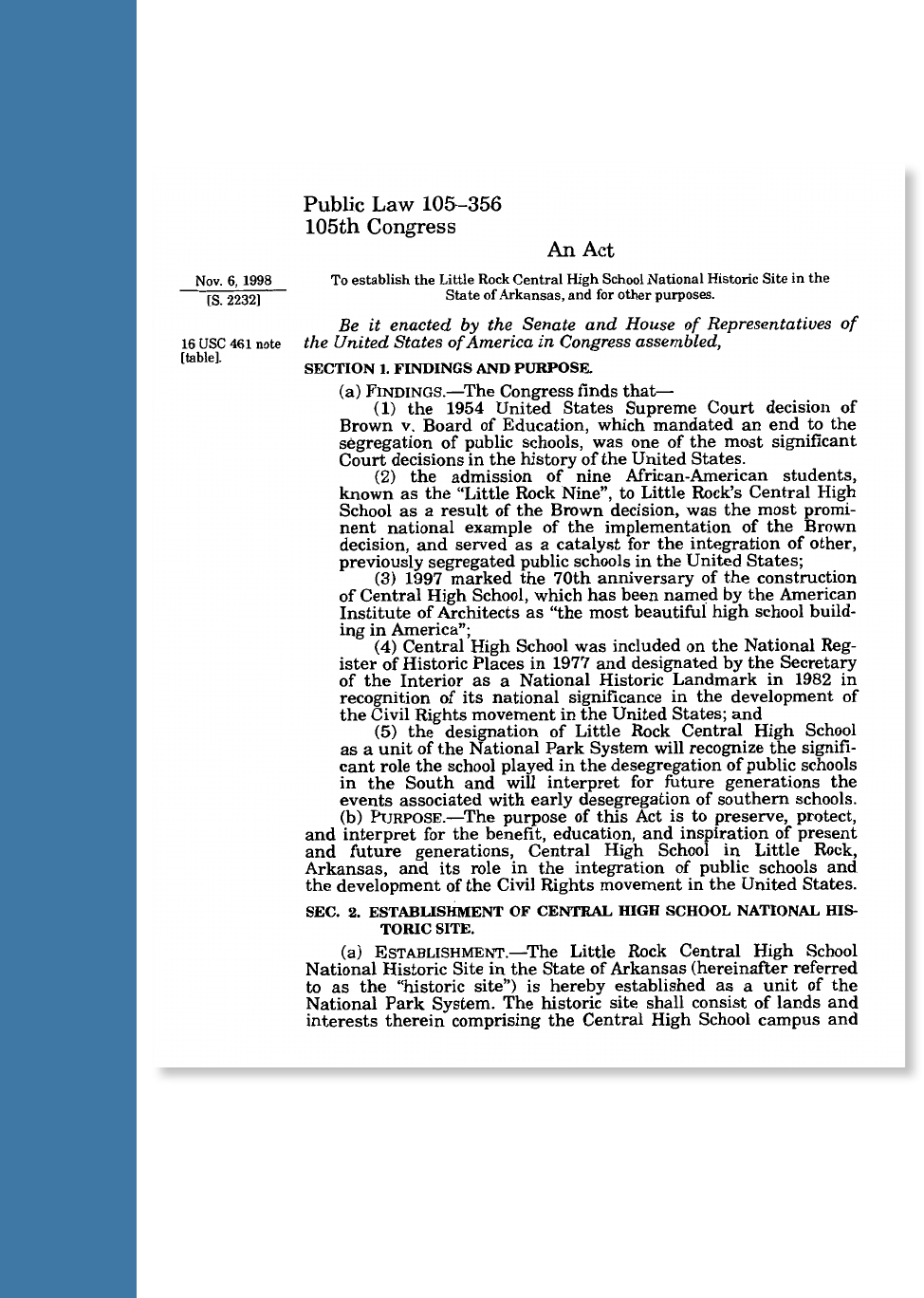
Foundation Document
32
Appendixes
Appendix A: Enabling Legislation for Little Rock Central
High School National Historic Site
Establishment of CHSC
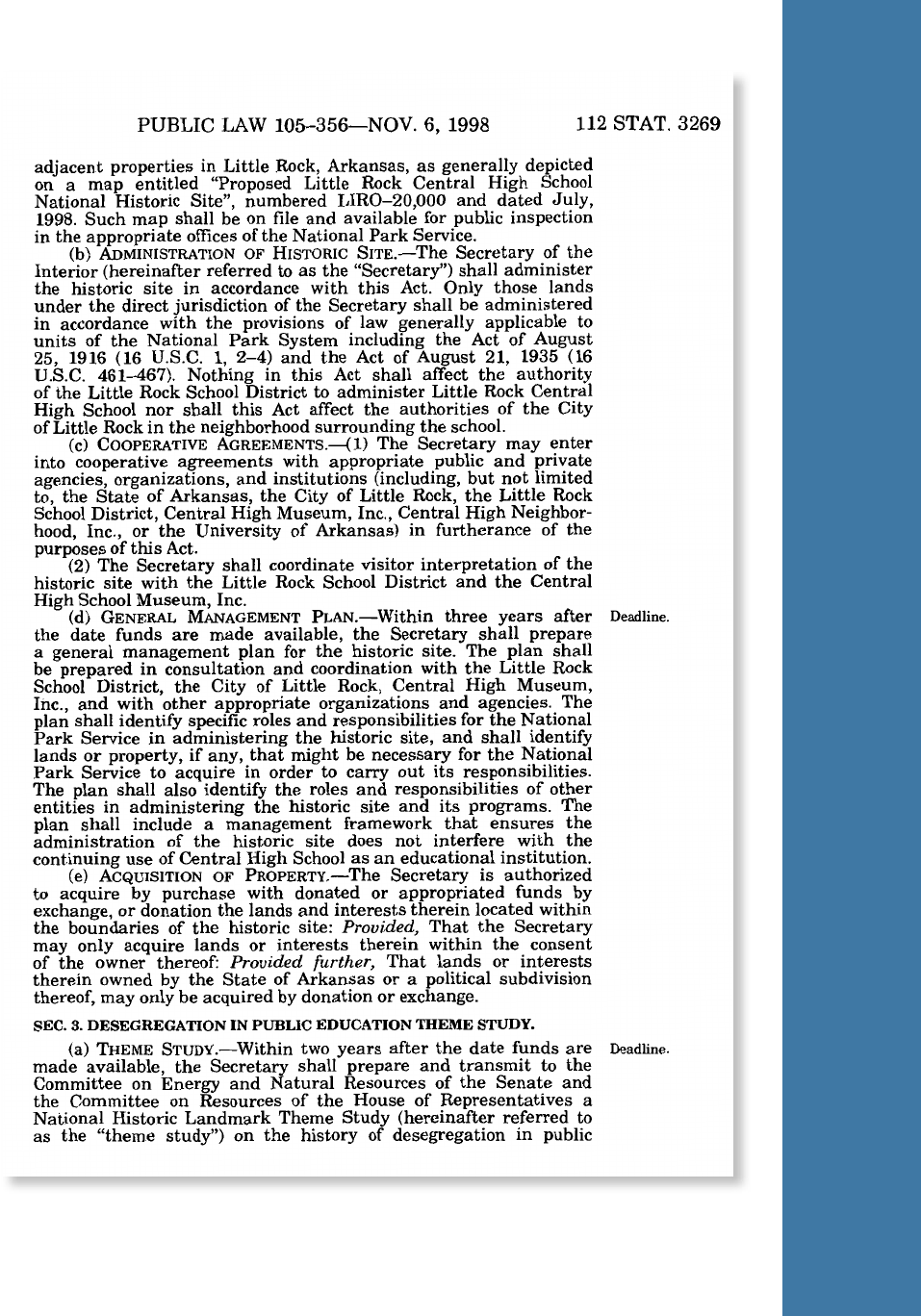
33
Little Rock Central High School National Historic Site
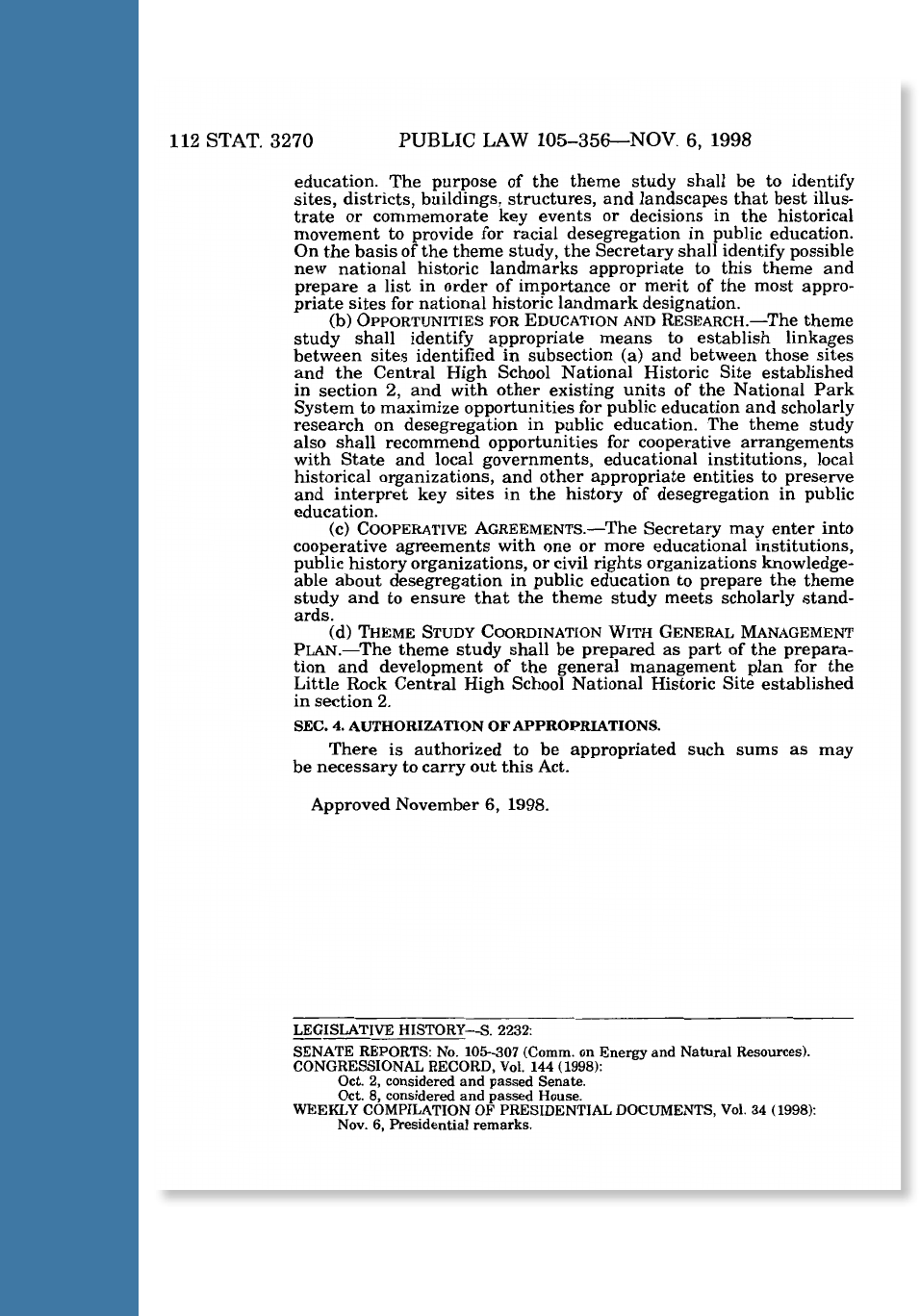
Foundation Document
34

35
Little Rock Central High School National Historic Site
Appendix B: Related Federal Legislation, Regulations, and
Executive Orders
Management decisions at Little Rock Central High School National Historic Site are based
on specific laws, policies, and regulations designed to protect environmental quality, preserve
historic resources, promote public enjoyment of the site, and ensure that the benefits and costs
of federal action are equally shared by all citizens. The primary laws of particular importance to
the decision-making process and management in the National Park Service are outlined below.
The Organic Act of 1916 (16 USC 1, et seq.). The National Park Service Organic Act
remains after 100 years the core of NPS authority and the definitive statement of the purposes
of the parks and of the National Park Service mission: “to promote and regulate the use of
the federal areas known as national parks, monuments, and reservations . . . by such means
and measures as conform to the[ir] fundamental purpose . . . to conserve the scenery and the
natural and historic objects and the wild life therein and to provide for the enjoyment of the
same in such a manner and by such means as will leave them unimpaired for the enjoyment of
future generations.”
General Authorities Act of 1970 (16 USC 1). This Act affirms that all national park areas are
“united through their interrelated purposes and resources into one national park system as
cumulative expressions of a single national heritage.”
The Redwood Act of 1978 (16 USC 1a-1). Congress supplemented and clarified the
provisions of the Organic Act through enactment of the General Authorities Act in 1970, and
again through enactment of a 1978 amendment to that law (the “Redwood Amendment”)
contained in a bill expanding Redwood National Park. This amendment states that the
provisions of the Organic Act apply to all units of the national park system. A key phrase is that
activities “shall not be exercised in derogation of the values and purposes for which these areas
have been established.” It is applicable unless Congress has “directly and specifically provided”
otherwise. This amendment also affirms that, if a conflict occurs between visitor use and
protection of resources, the intent of Congress is to favor resource protection.
National Environmental Policy Act of 1969 (42 USC 4321–4370). This landmark
environmental protection legislation requires federal agencies to integrate environmental
values into their decision-making processes by considering the environmental impacts of their
proposed actions and reasonable alternative to those actions. The National Environmental
Policy Act establishes the format and process that the National Park Service must use in
preparing the environmental analyses that are incorporated into the general management
planning process. The results of these analyses are presented to the public, federal agencies,
and public officials in document format for consideration prior to taking official action or
making official decisions.
Council on Environmental Quality Regulations, as amended (40 CFR 1500–1508). These
regulations implement the National Environmental Policy Act and provide guidance to federal
agencies in the preparation of environmental documents identified under the act.
National Historic Preservation Act of 1966, as amended (54 USC §300101 et seq.;
36 CFR 800). The purpose of this Act is to protect and preserve historic properties which
includes any prehistoric or historic district, site, building, structure, or object included in, or
eligible for inclusion in, the National Register of Historic Places, including artifacts, records,
and material remains relating to the district, site, building, structure, or object. Section 110
requires that the National Park Service identify and nominate all eligible resources under
its jurisdiction to the National Register of Historic Places. Section 106 of the act requires
that federal agencies with direct or indirect jurisdiction take into account the effect of any
actions on cultural resources listed in or eligible for inclusion in the National Register of
Historic Places.
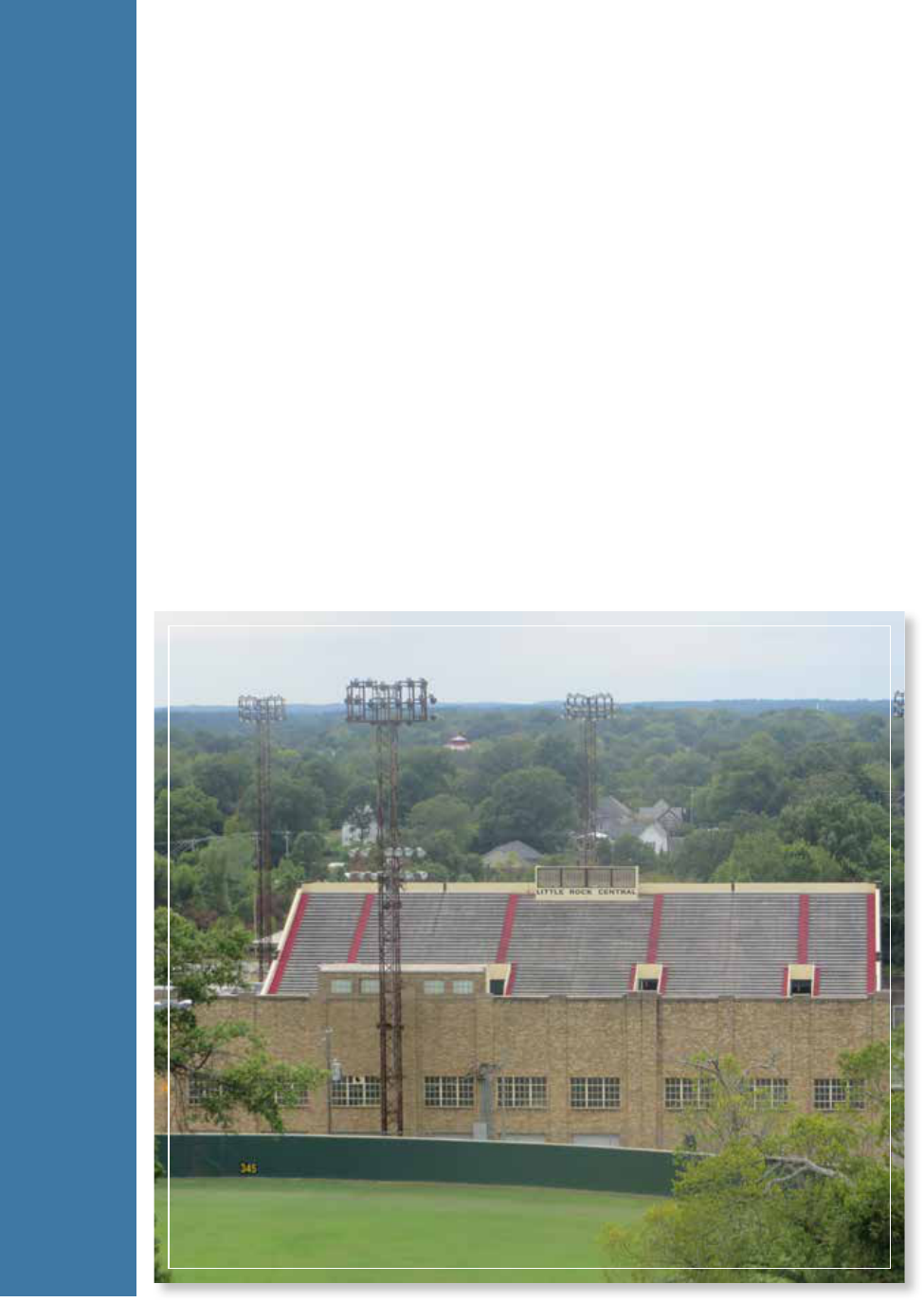
Foundation Document
36
Executive Order 11593, “Protection and Enhancement of the Cultural Environment,”
May 13, 1971. This Executive Order directs federal agencies to inventory cultural properties
under their jurisdiction, to nominate to the National Register of Historic Places all federally
owned properties that meet the criteria, to use due caution until the inventory and nomination
processes are completed, and also to assure that federal plans and programs contribute to
preservation and enhancement of nonfederal properties.
Archeological and Historic Preservation Act of 1974, as amended (16 USC 469–469c).
This Act requires survey, recovery, and preservation of significant scientific, prehistorical,
historical, archeological, or paleontological data when such data may be destroyed due to a
federal project. The act directs federal agencies to notify the Secretary of the Interior whenever
they find that such a project may cause loss or damage.
“General Provisions” (36 CFR 1). 36 CFR 1 provides the regulations “for the proper use,
management, government, and protection of persons, property, and natural and cultural
resources within areas under the jurisdiction of the NPS.” These regulations are used to
fulfill the statutory purposes of National Park System units—to conserve scenery, natural and
historical objects, and wildlife and to provide for the enjoyment of those resources in such a
manner as to leave them unimpaired for future generations.
NPS Management Policies 2006. NPS Management Policies 2006 is the basic servicewide
policy document of the National Park Service. It is the highest of three levels of guidance
documents in the NPS directives system. The directives system is designed to provide NPS
management and staff with clear and continuously updated information on NPS policy and
required and/or recommended actions, as well as any other information that would aid in the
effective management of parks and programs.

37
Little Rock Central High School National Historic Site
Other Relevant Laws, Executive Orders, and Regulations
· Historic Sites Act of 1935
· Museum Properties Management Act of 1955, as amended
· “Protection of Historic Properties” (36 CFR 800)
· Americans with Disabilities Act of 1990
· Architectural Barriers Act
· Architectural Barriers Act Accessibility Standards 2006
· Secretarial Order 3289, “Addressing the Impacts of Climate Change on America’s
Water, Land, and Other Natural and Cultural Resources”
NPS Policy-Level Guidance
· Director’s Order 28: Cultural Resource Management
· The Secretary of the Interior’s Standards and Guidelines for Archeology and Historic
Preservation
· The Secretary of the Interior’s Standards for the Treatment of Historic Properties
· The Secretary of the Interior’s Standards for the Treatment of Historic Properties with
Guidelines for the Treatment of Cultural Landscapes
· Director’s Order 24: NPS Museum Collections Management
· NPS Museum Handbook, Parts I, II, and III
· NPS Management Policies 2006 (chapter 4) “Natural Resource Management”
· NPS Management Policies 2006 (chapter 7) “Interpretation and Education”
· NPS Management Policies 2006 (chapter 8) “Use of the Parks”
· NPS Management Policies 2006 (chapter 9) “Park Facilities”
· Director’s Order 6: Interpretation and Education
· Director’s Order 11D: Records and Electronic Information Management
· Director’s Order 17: National Park Service Tourism
· Director’s Order 42: Accessibility for Visitors with Disabilities in National Park Service
Programs and Services
· Director’s Order 50C: Public Risk Management Program
· Director’s Order 78: Social Science

Foundation Document
38
Appendix C: Past and Ongoing Park Planning and Data
Collection Efforts
· Emergency management plan (2014)
· Historic structure report (2010)
· Cultural landscape report (2009)
· National Register of Historic Places documentation of the historic district (1977 – 2012)
· Long-range interpretive plan (2004)
· General management plan and environmental impact statement (2002)
· Little Rock Central High School National Historic Site Special Resource Study (1998)
· Little Rock Central High School National Historic Site Cycle 5 Road Inventory (2011)
· Little Rock Central High School national historic landmark nomination (1982)
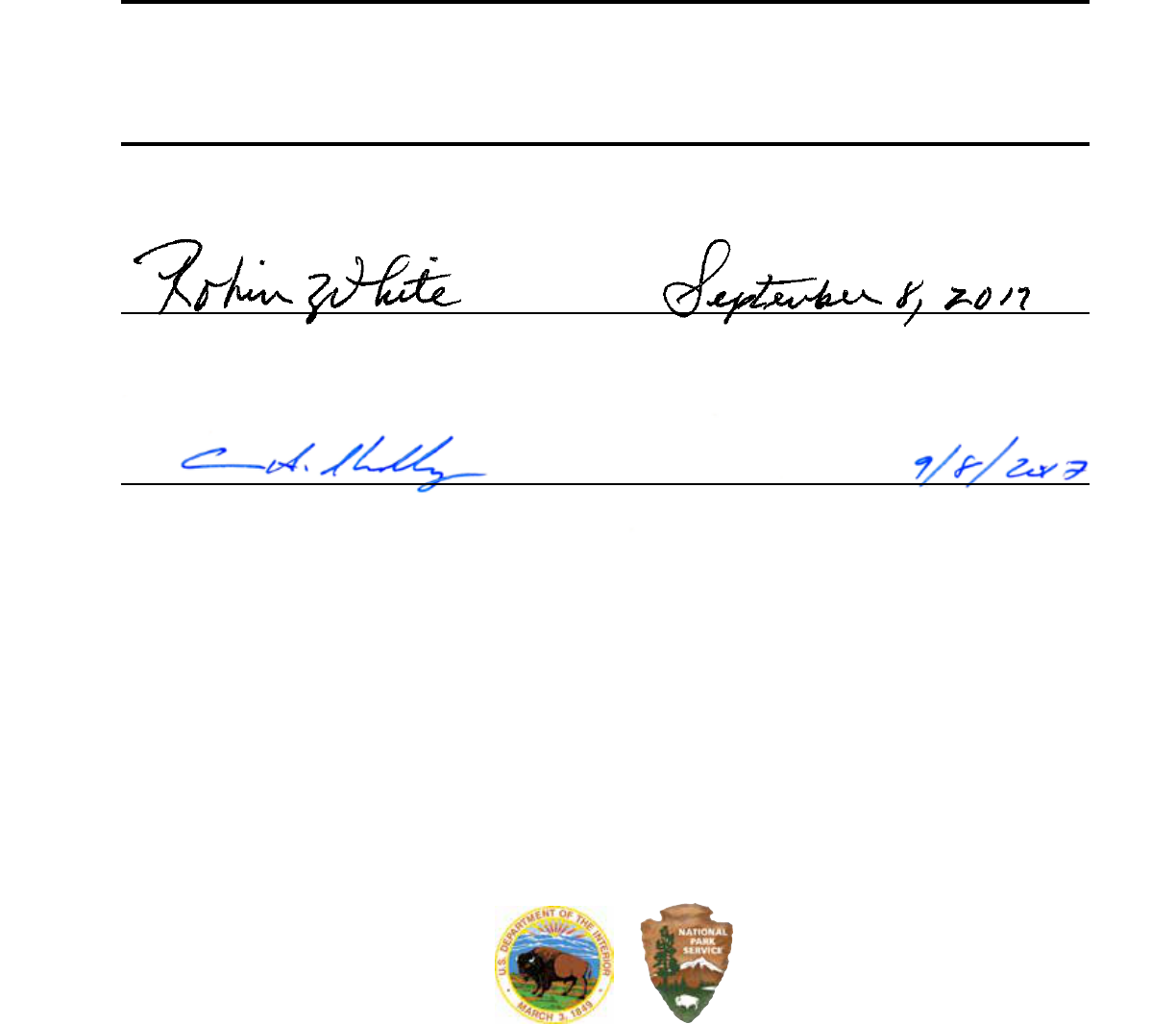
Midwest Region Foundation Document Recommendation
Little Rock Central High School National Historic Site
September 2017
This Foundation Document has been prepared as a collaborative effort between park and regional staff and
is recommended for approval by the Midwest Regional Director.
RECOMMENDED
Robin White, Superintendent, Little Rock Central High School National Historic Site Date
APPROVED
Cameron H. Sholly, Regional Director, Midwest Region Date
As the nation’s principal conservation agency, the Department of the Interior has responsibility for most
of our nationally owned public lands and natural resources. This includes fostering sound use of our land
and water resources; protecting our fish, wildlife, and biological diversity; preserving the environmental and
cultural values of our national parks and historic places; and providing for the enjoyment of life through
outdoor recreation. The department assesses our energy and mineral resources and works to ensure that their
development is in the best interests of all our people by encouraging stewardship and citizen participation in
their care. The department also has a major responsibility for American Indian reservation communities and
for people who live in island territories under U.S. administration.
CHSC 037/139368
December 2017
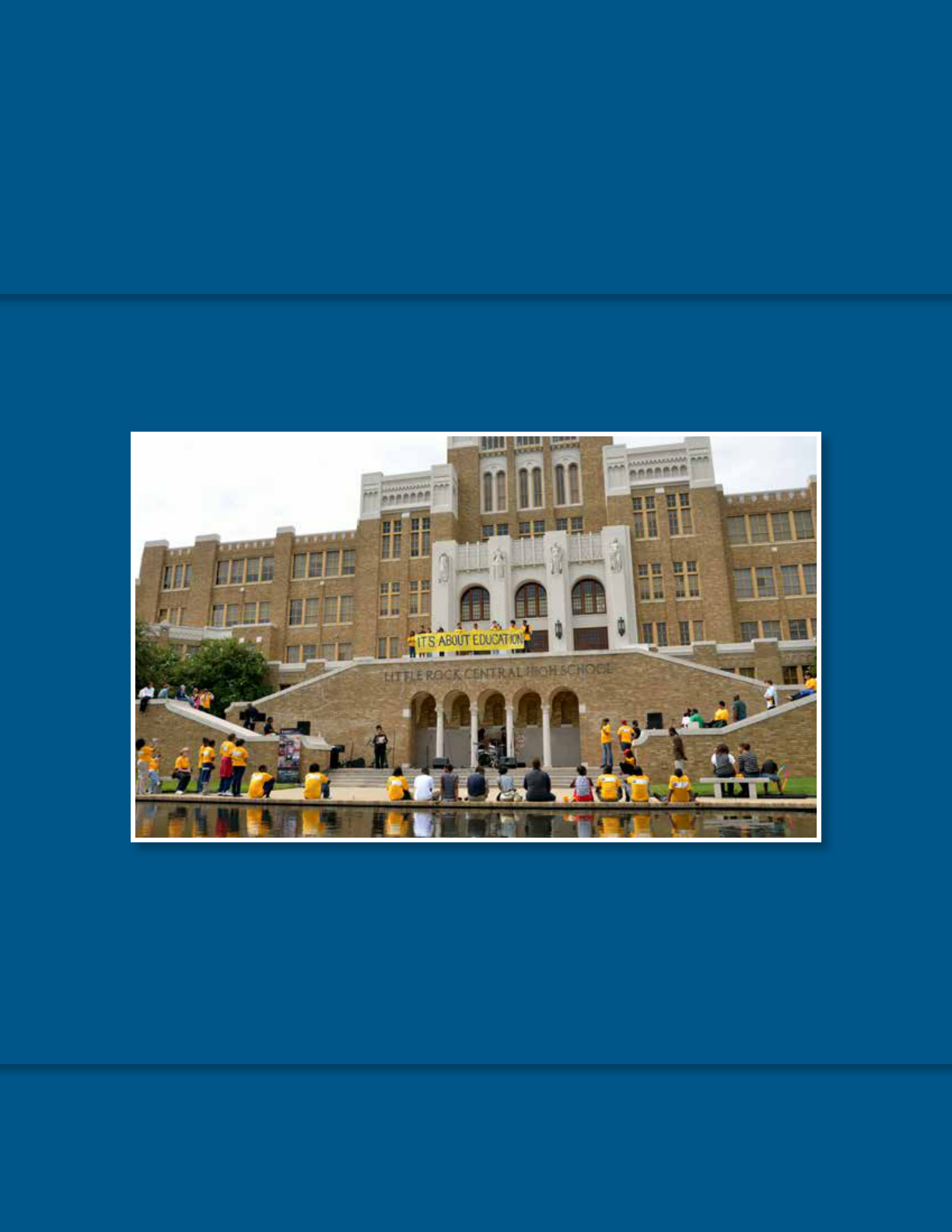
Foundation Document • Little Rock Central High School National Historic Site
NATIONAL PARK SERVICE • U.S. DEPARTMENT OF THE INTERIOR
